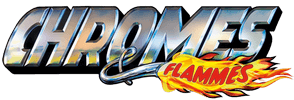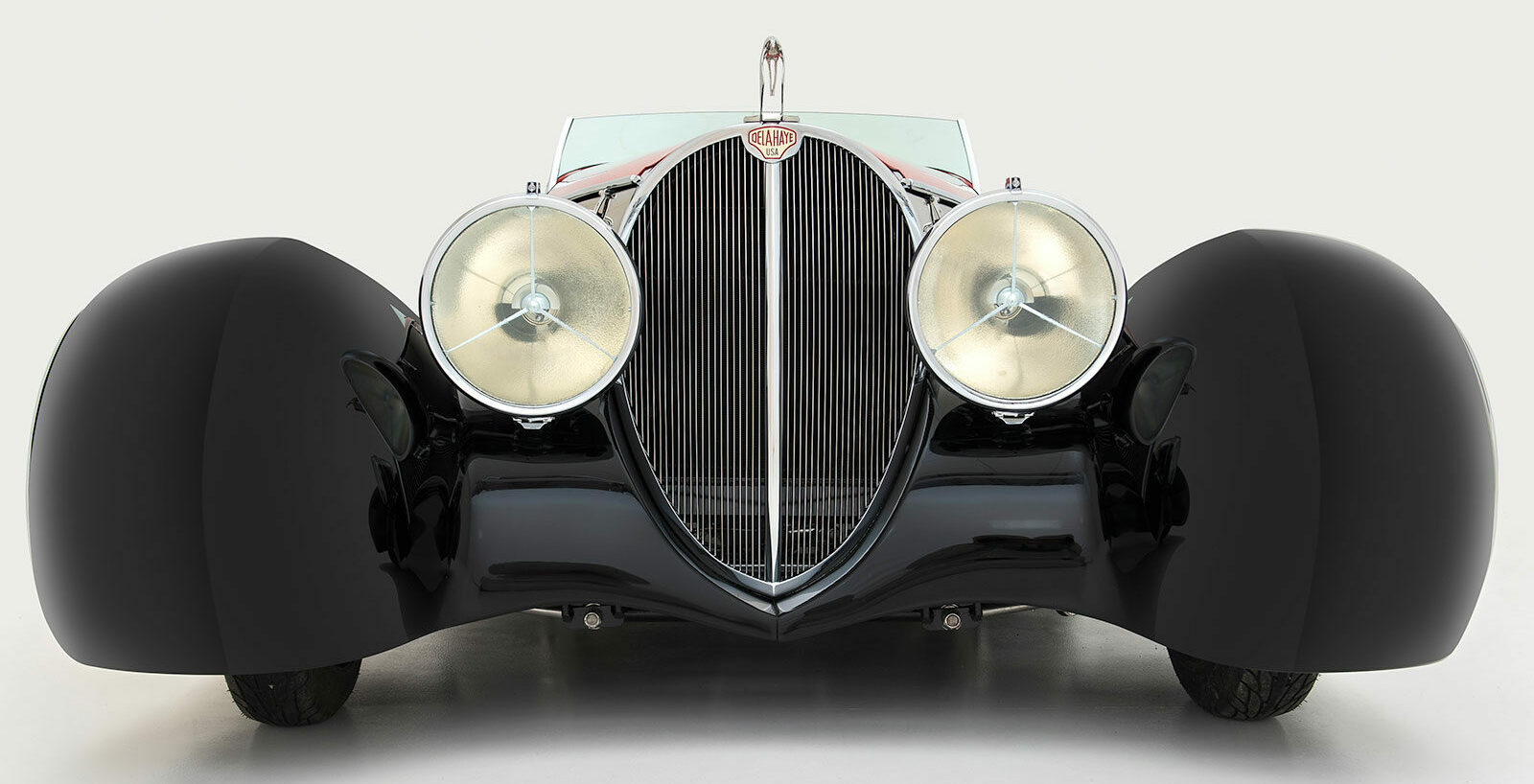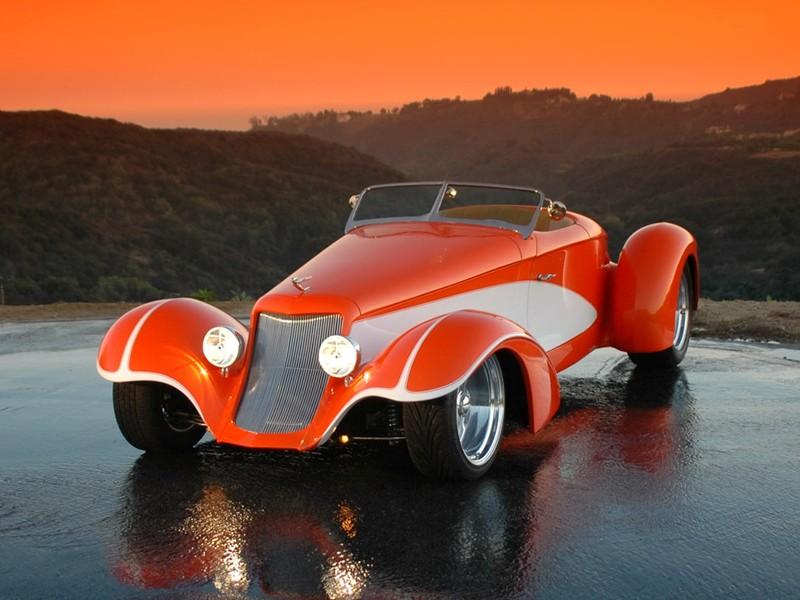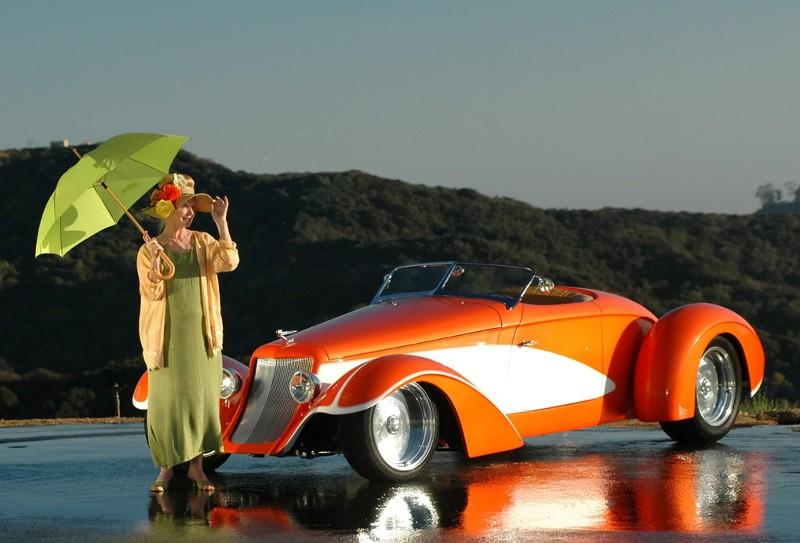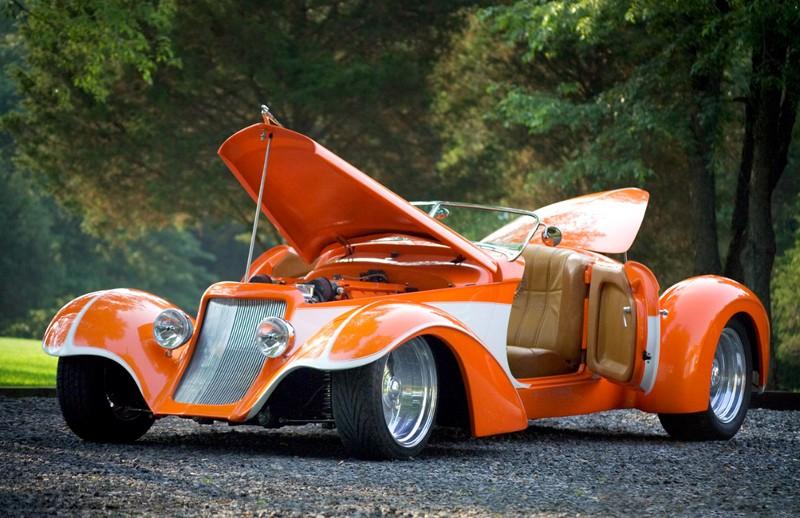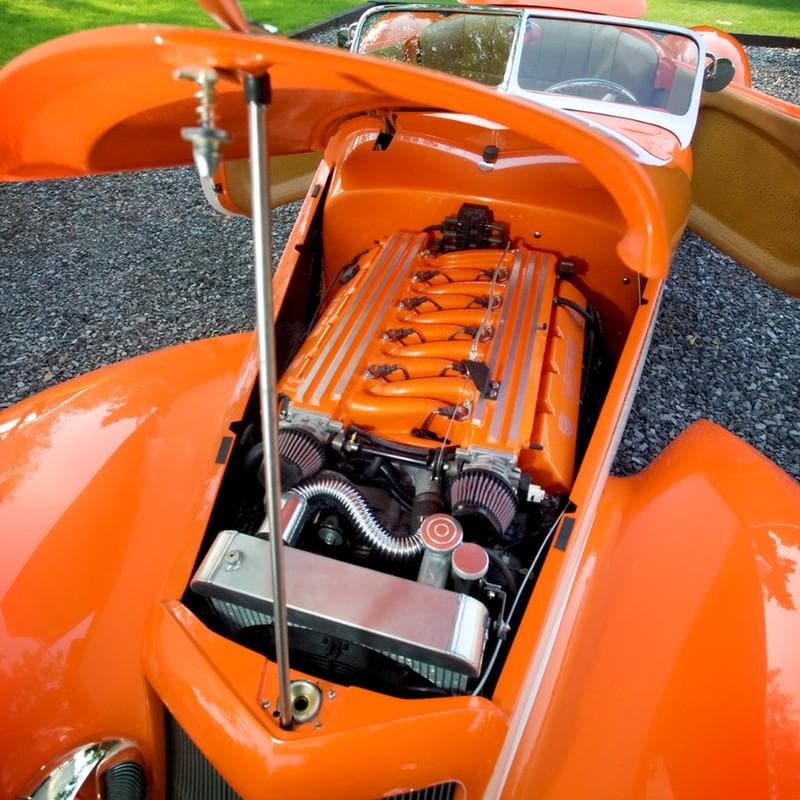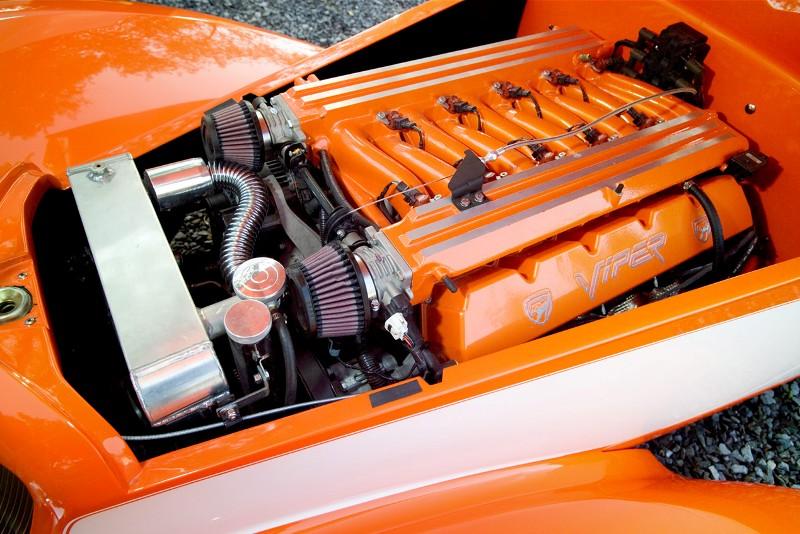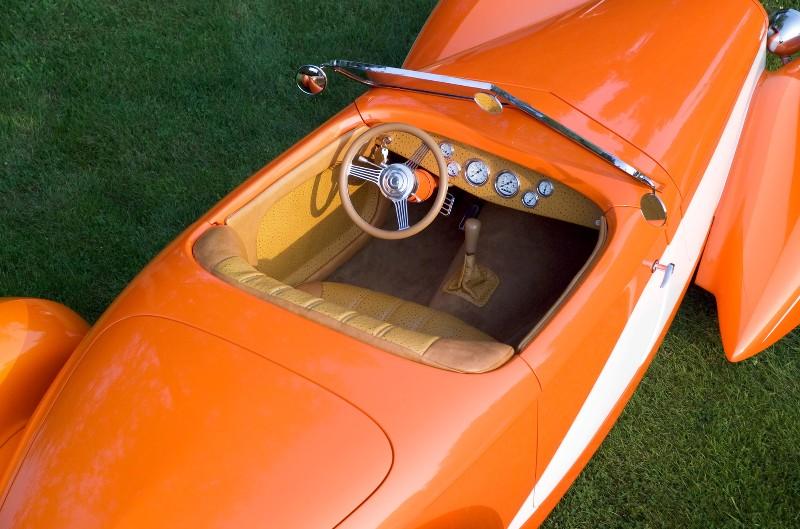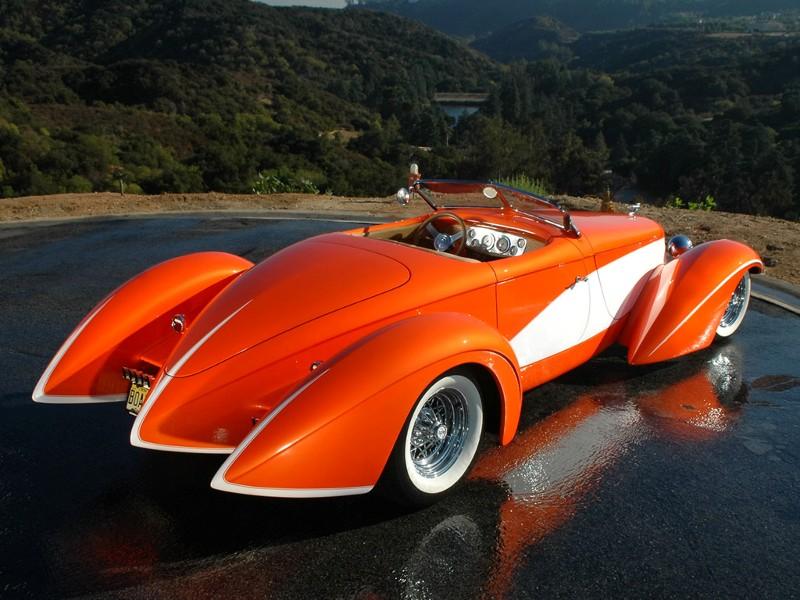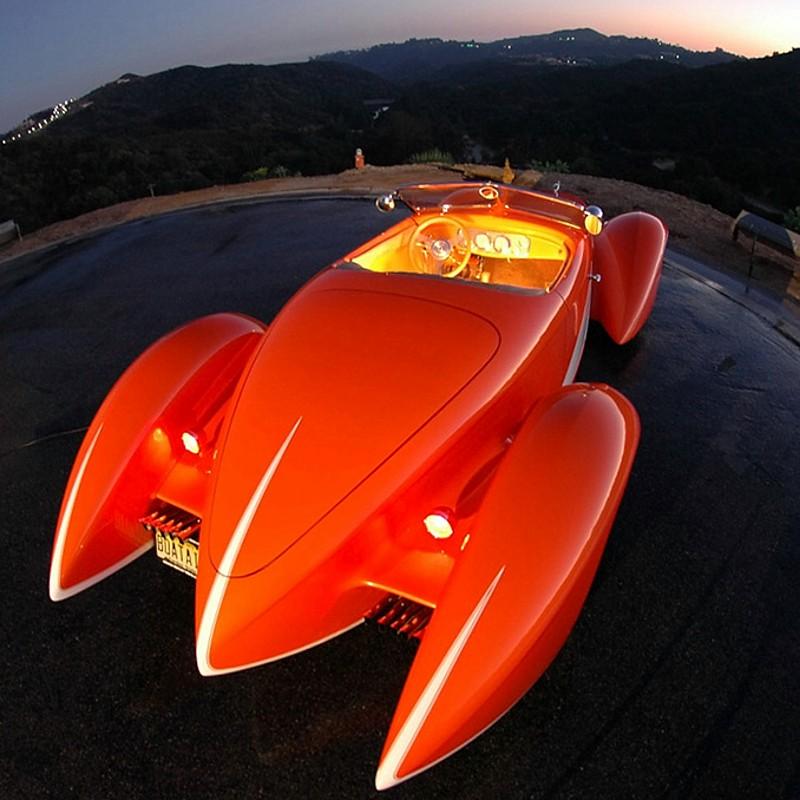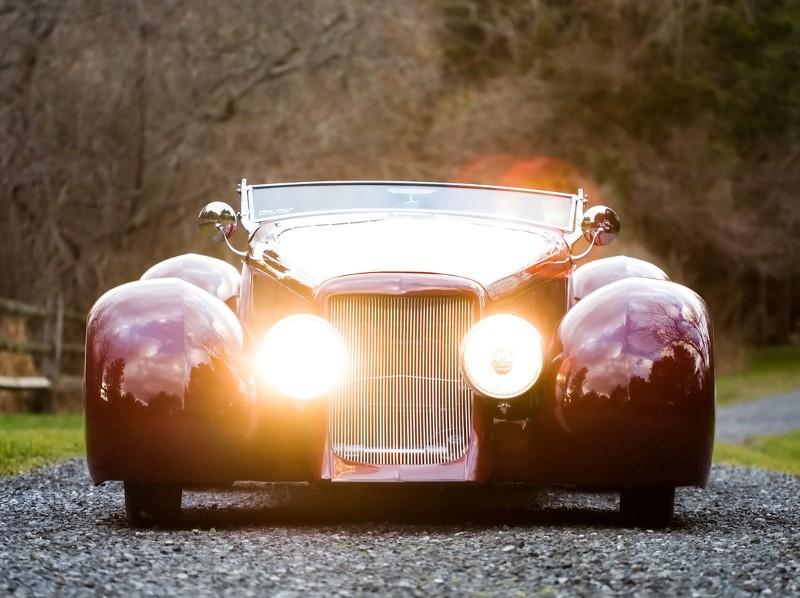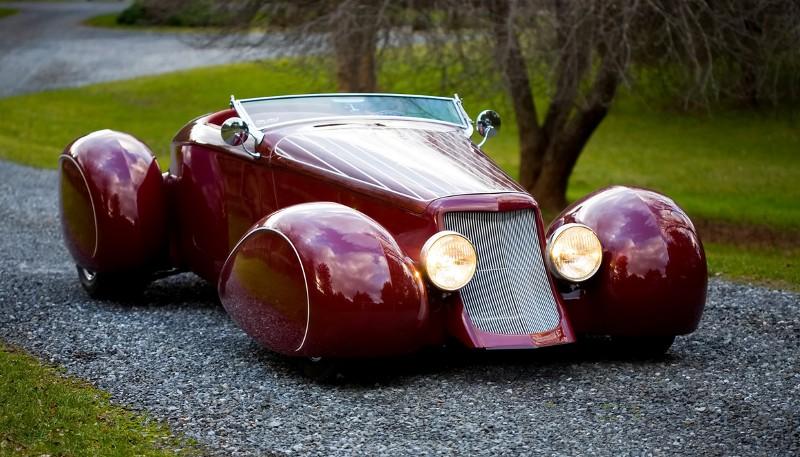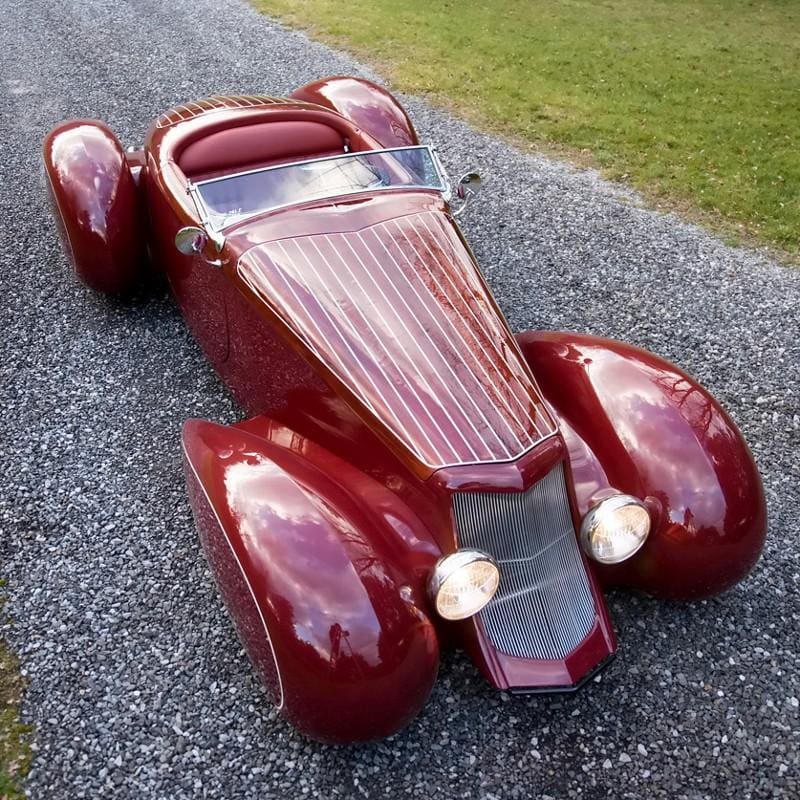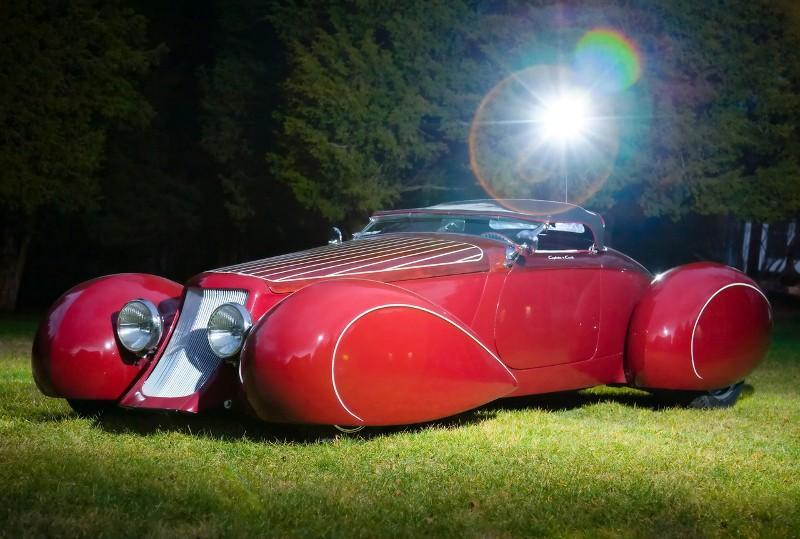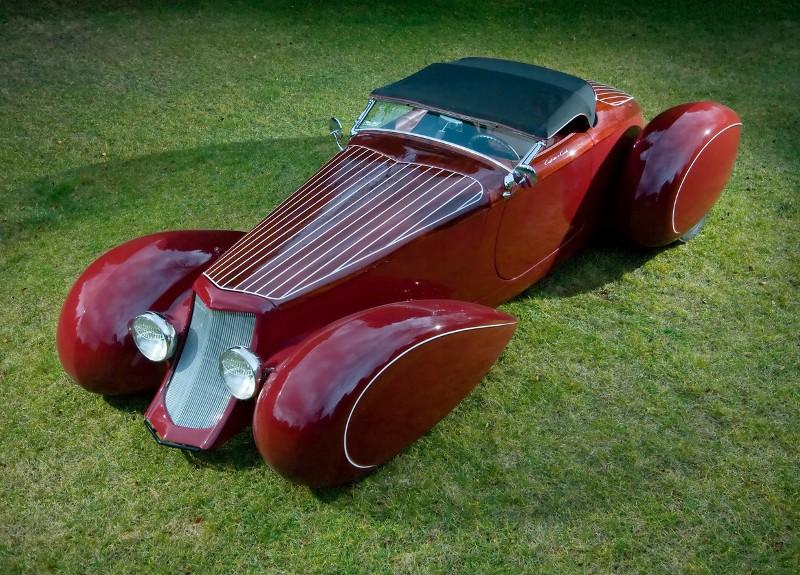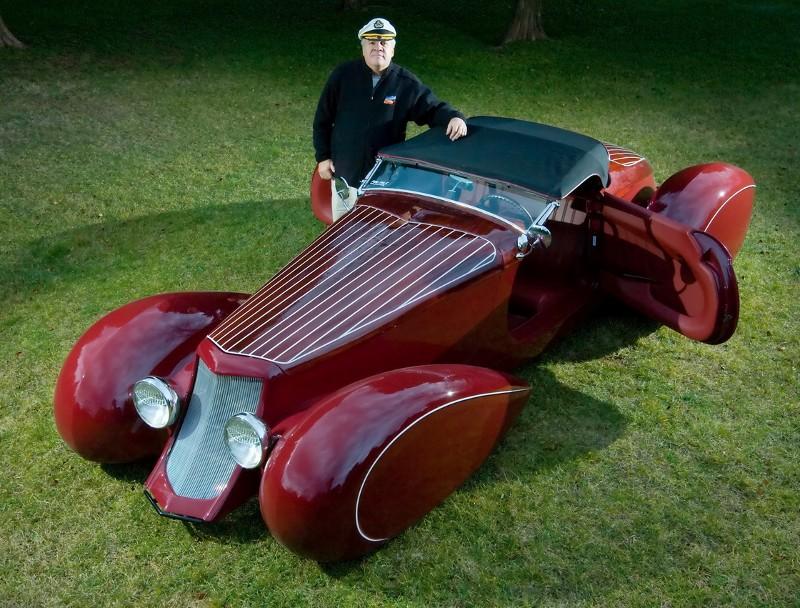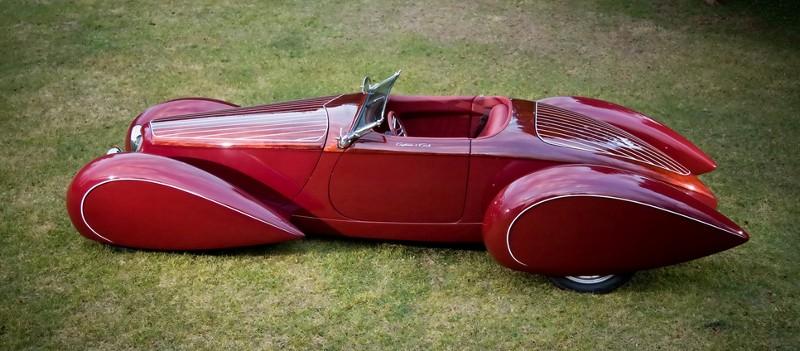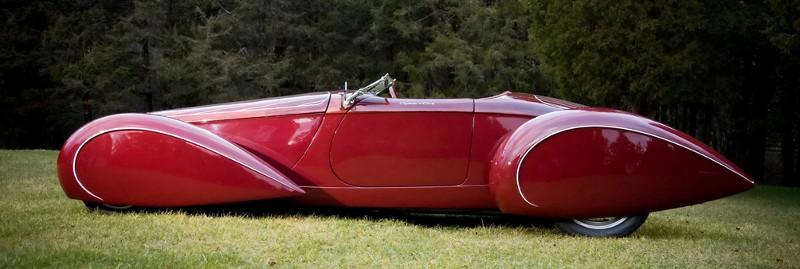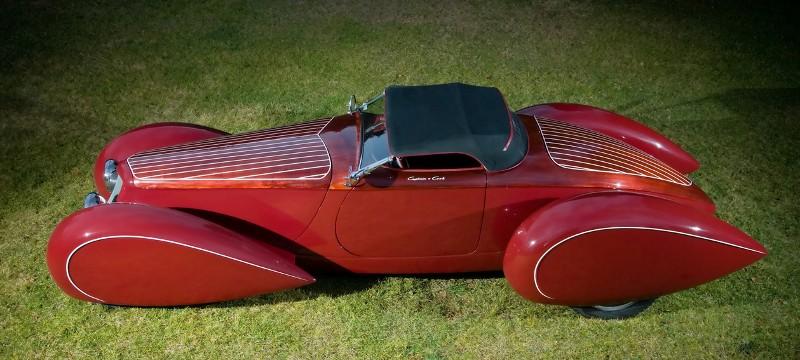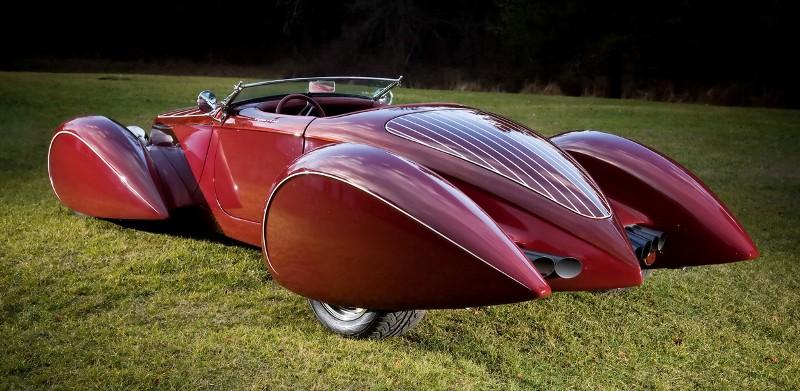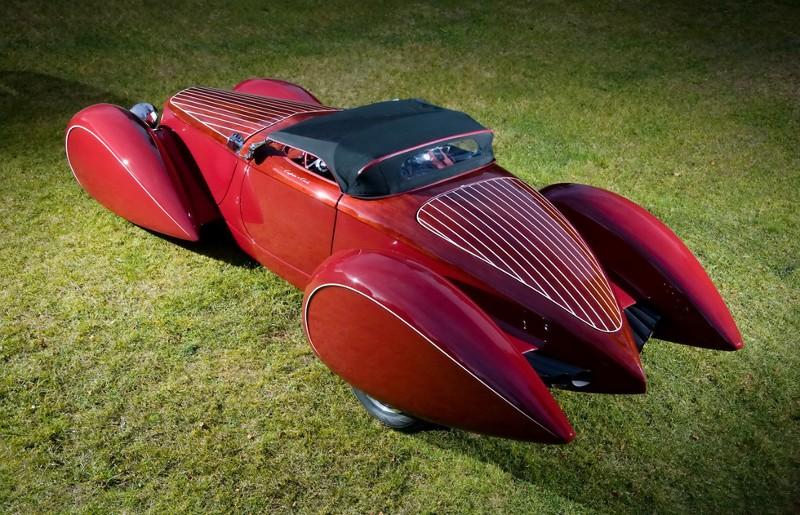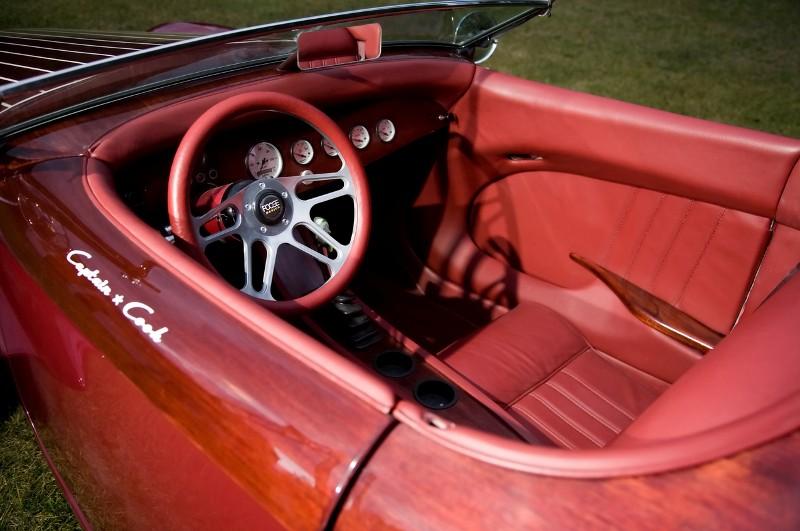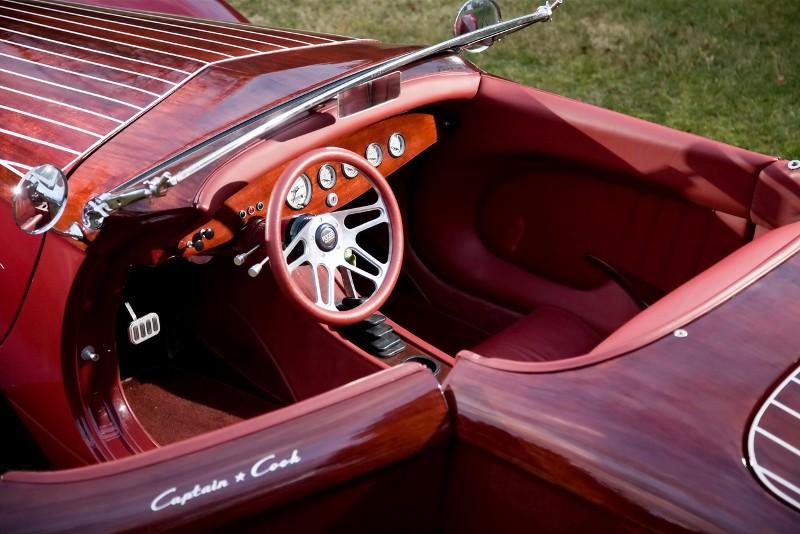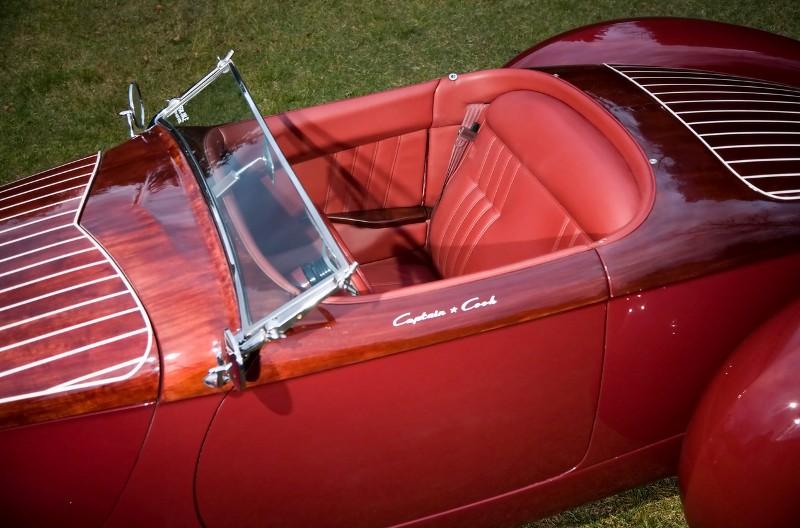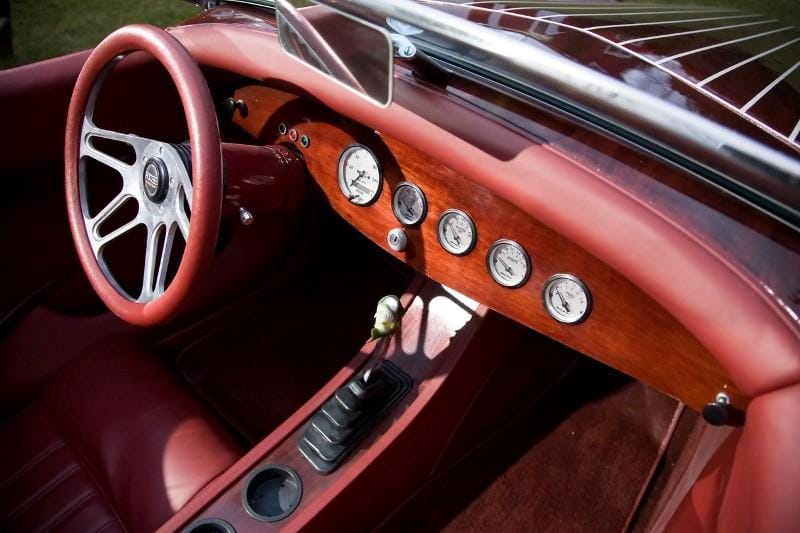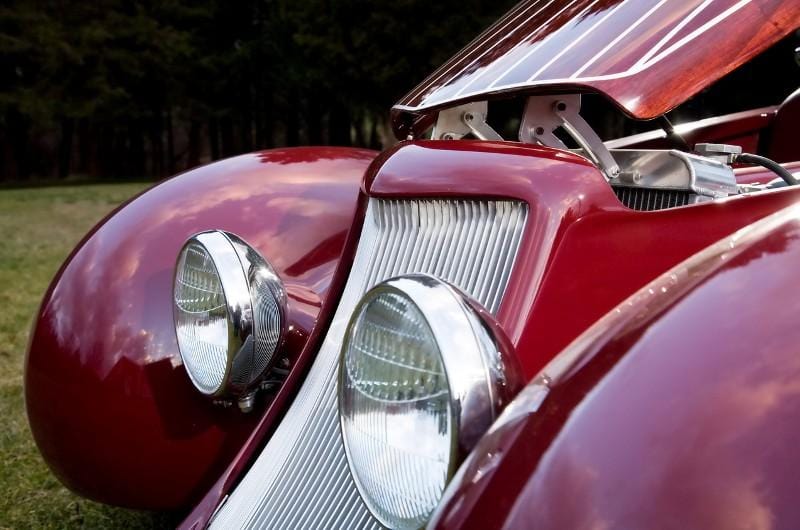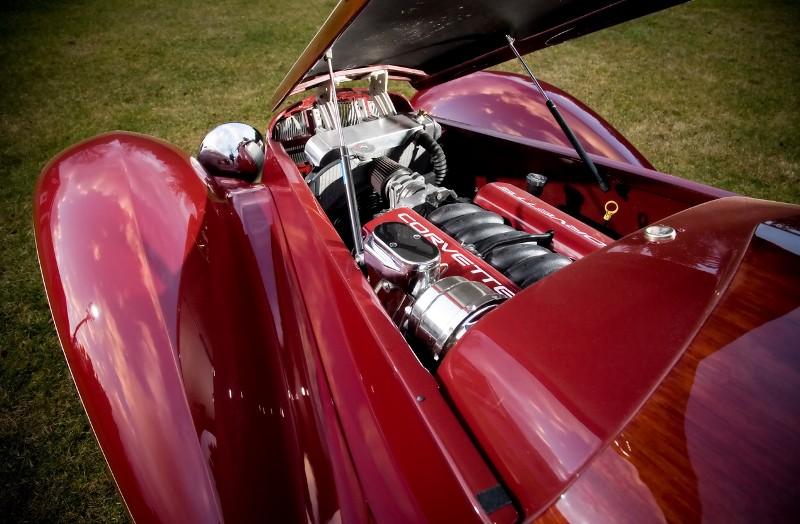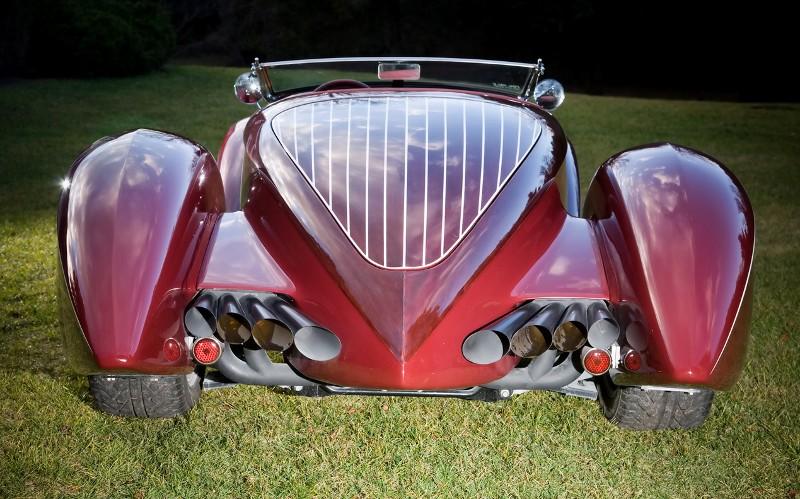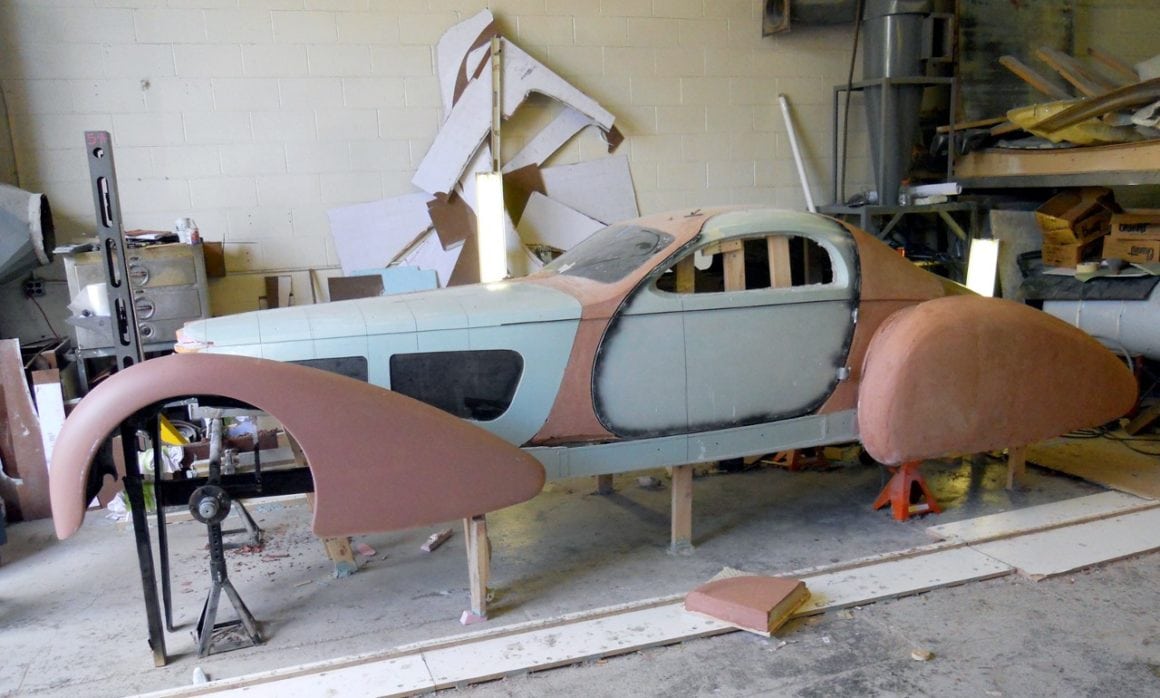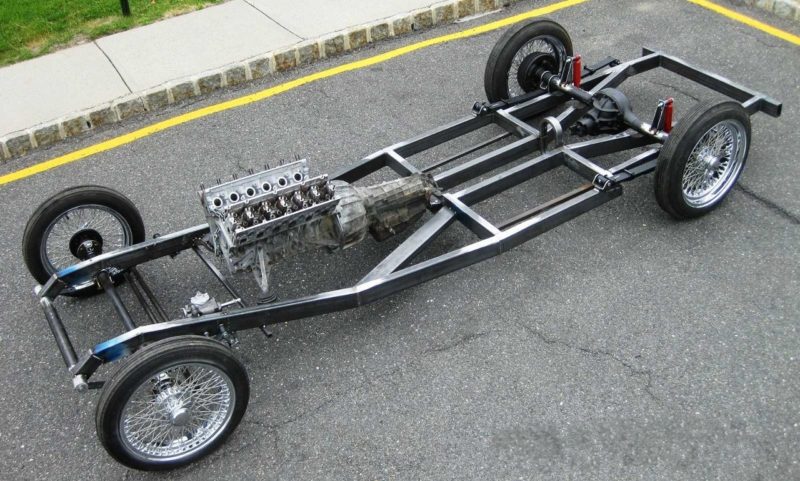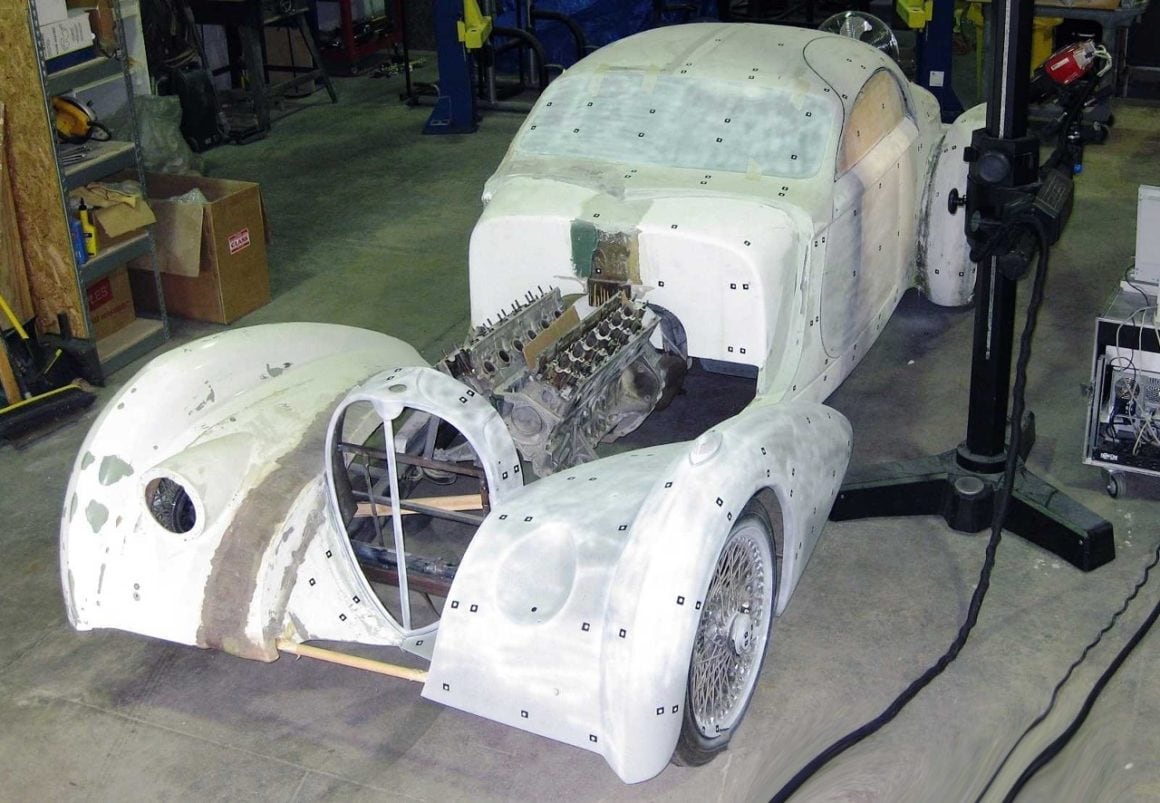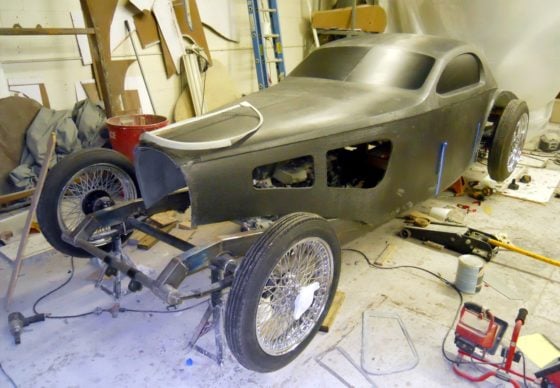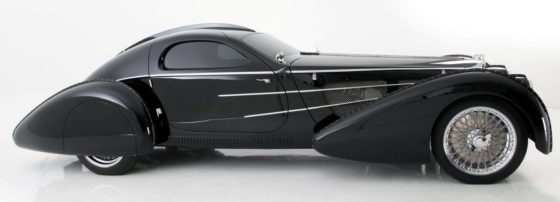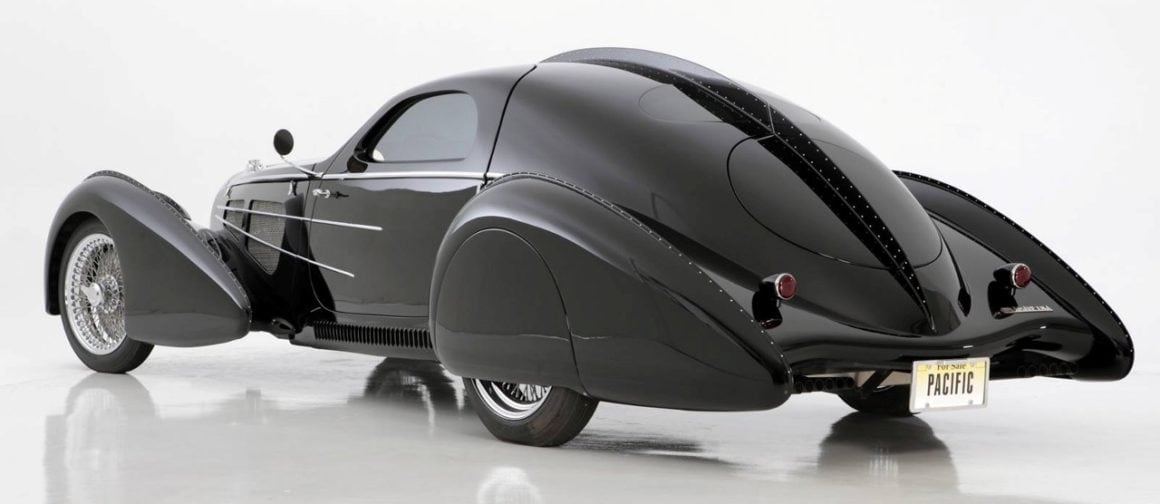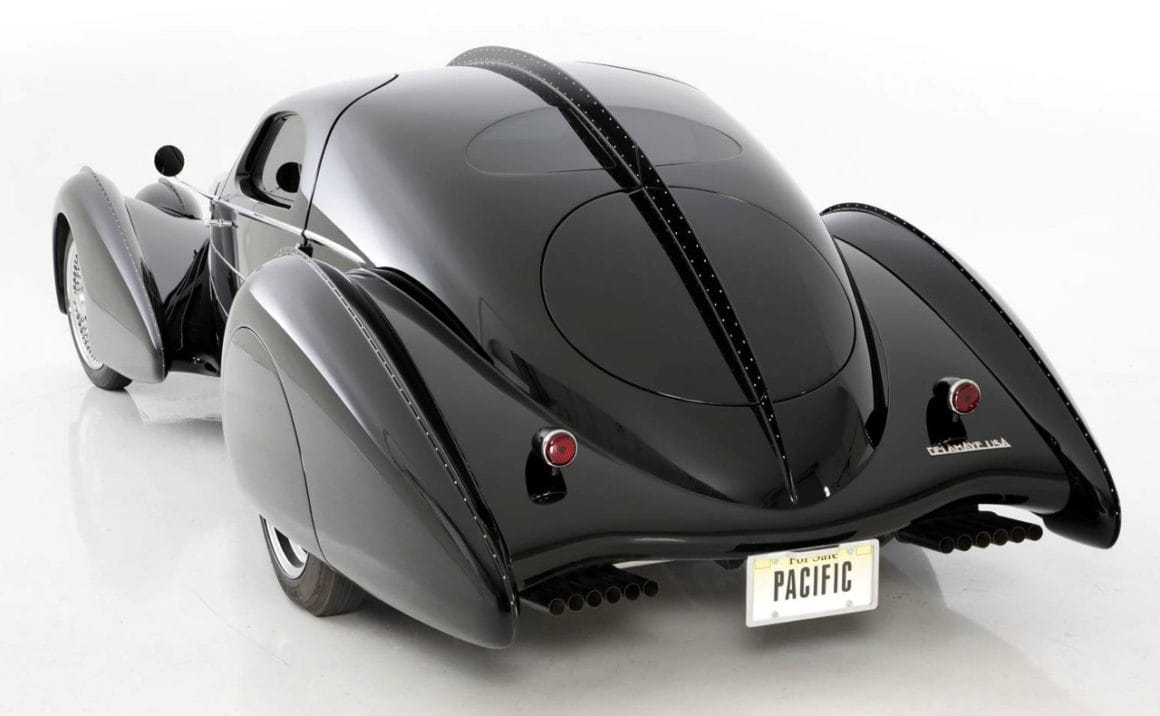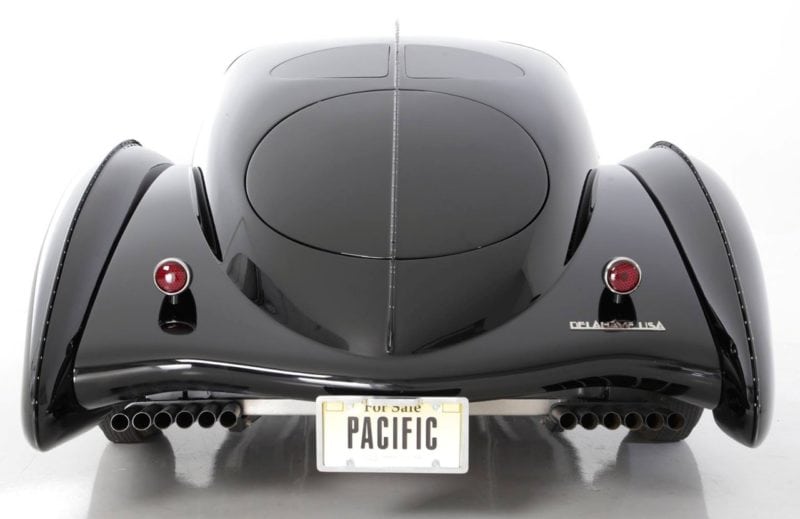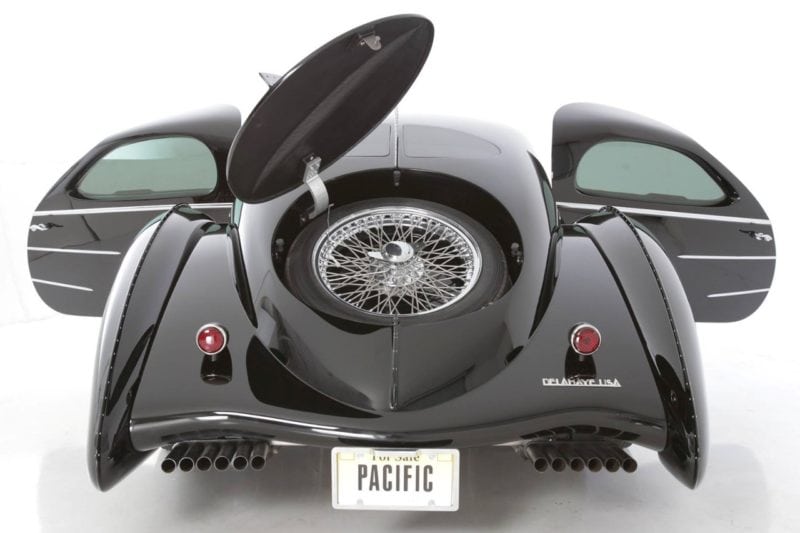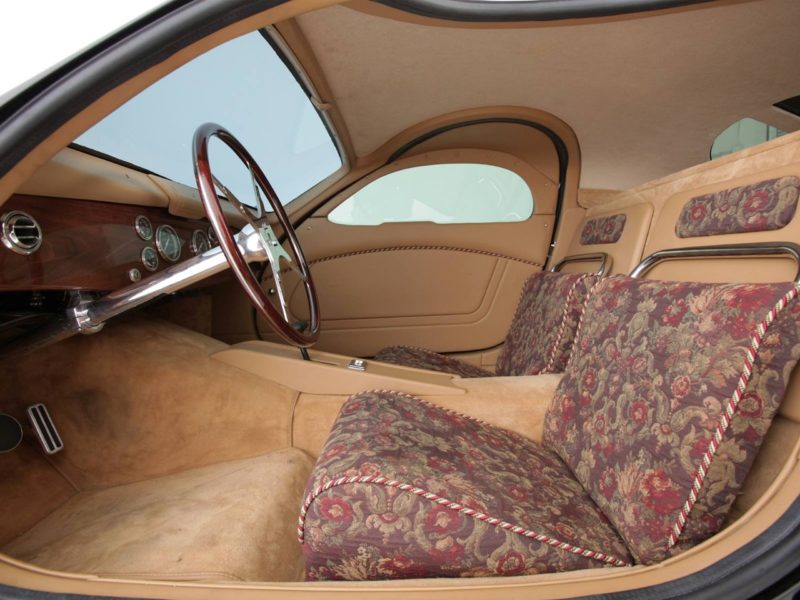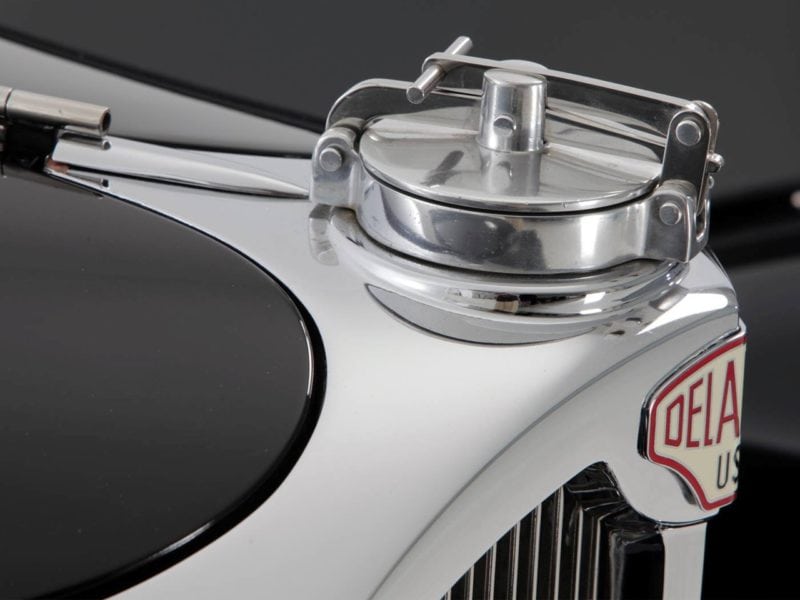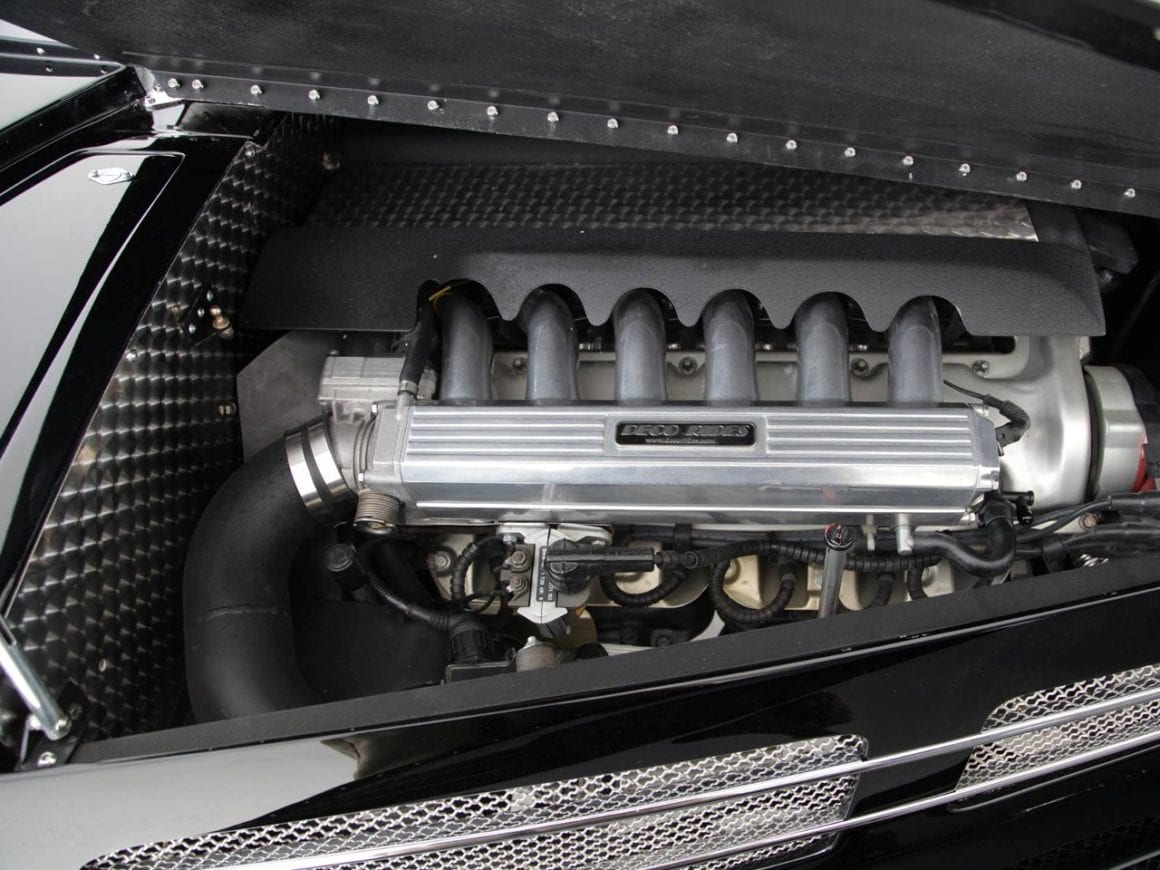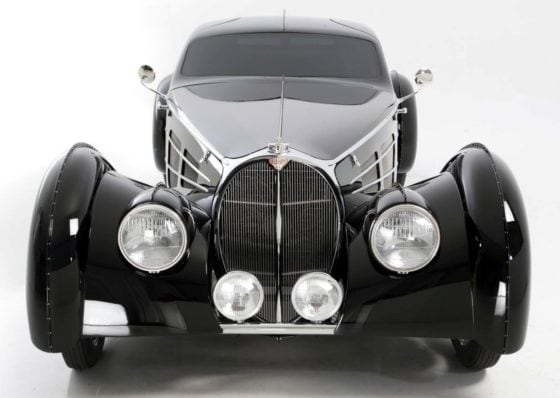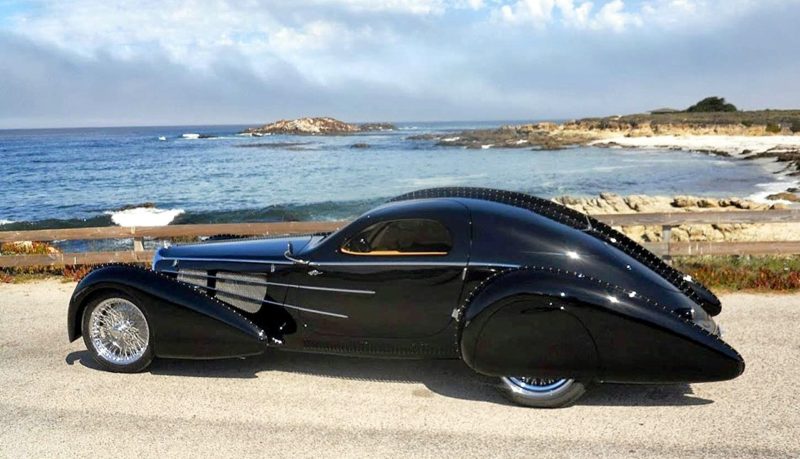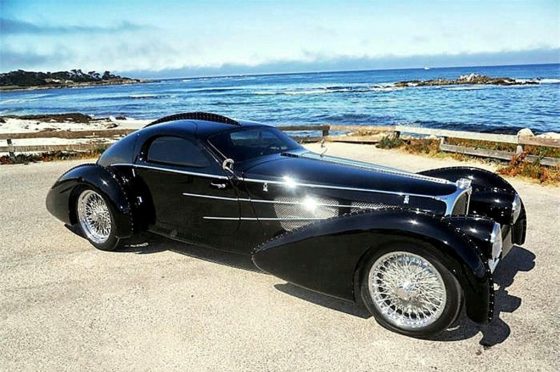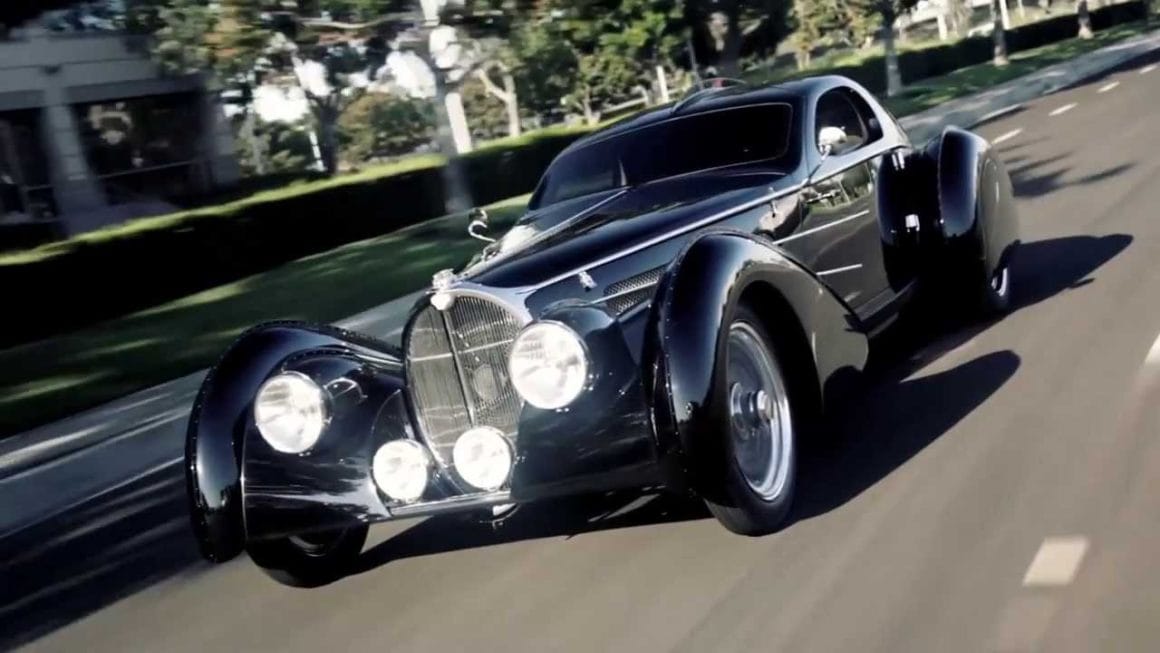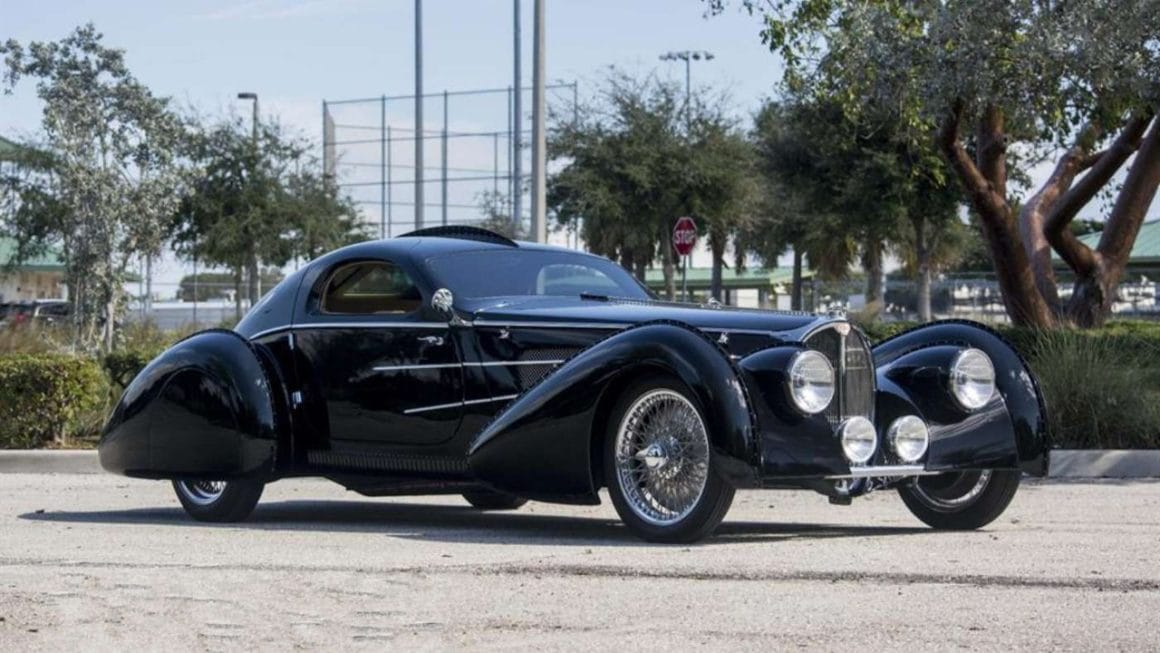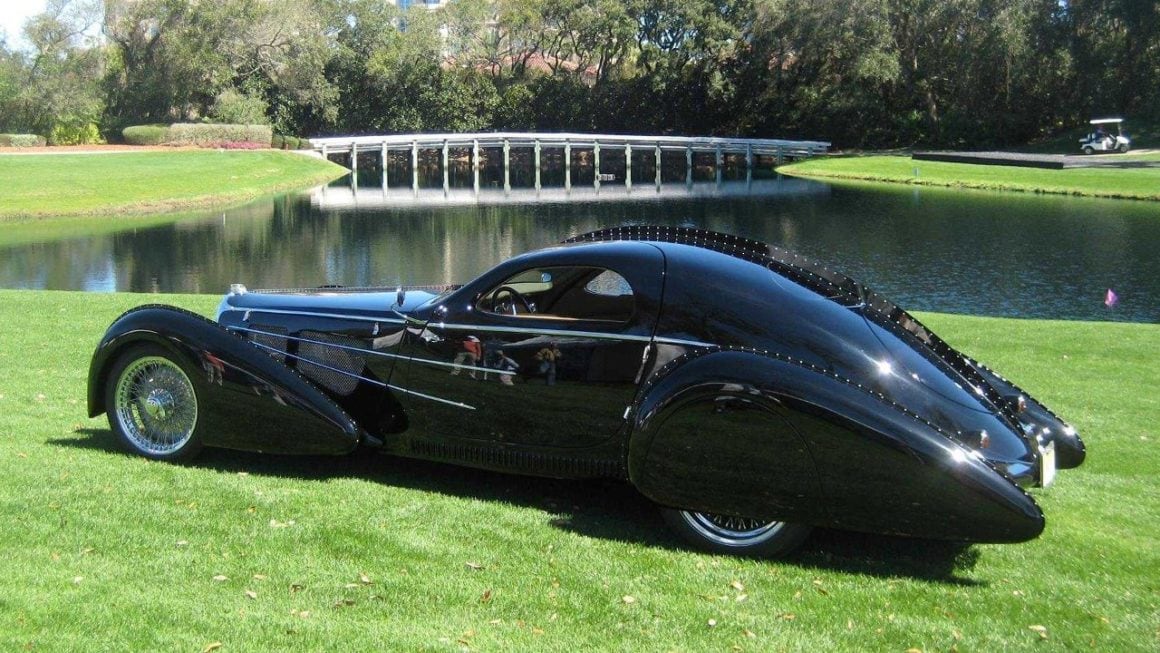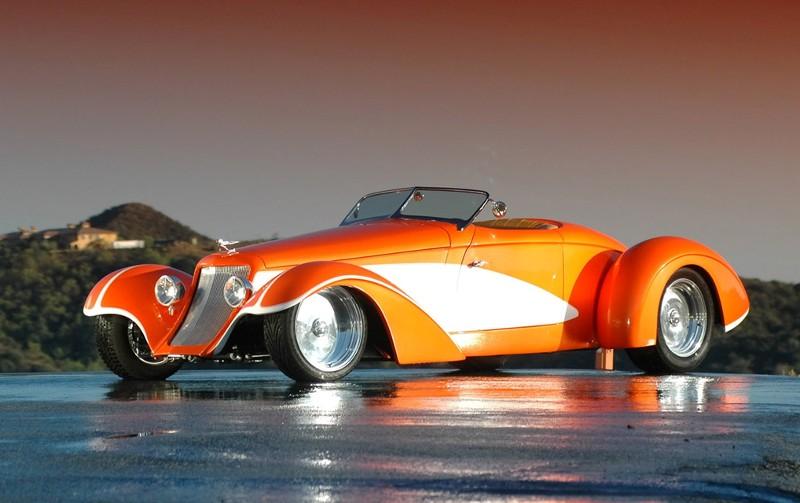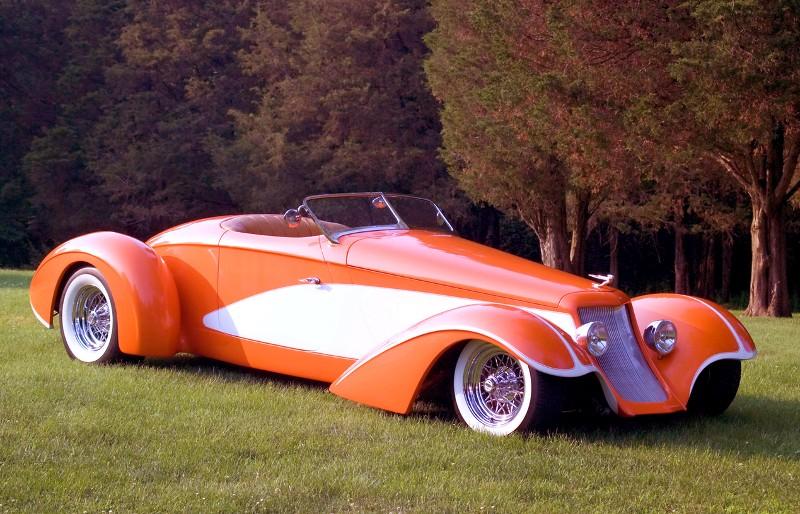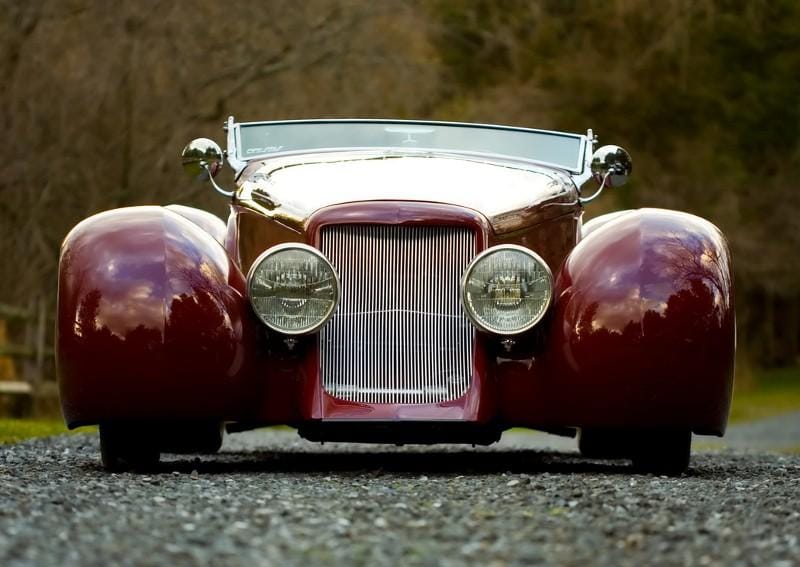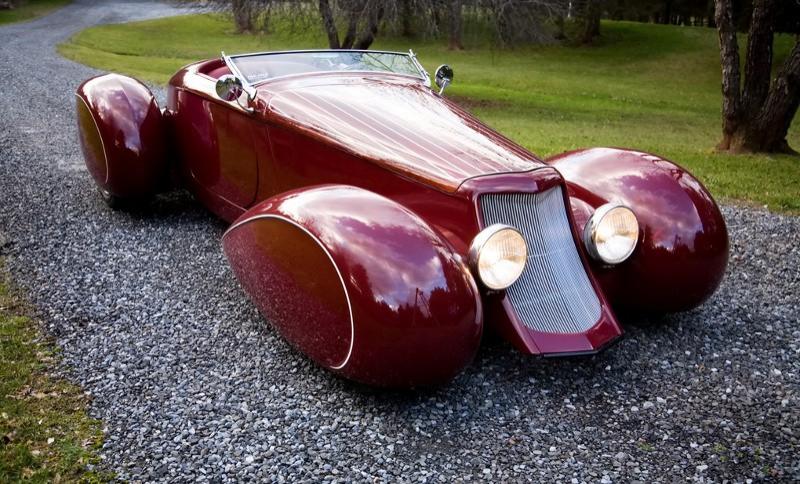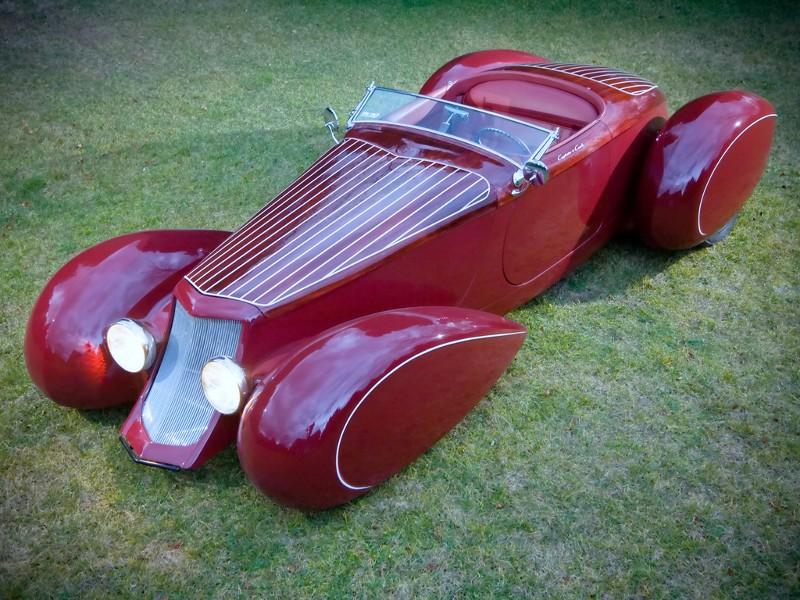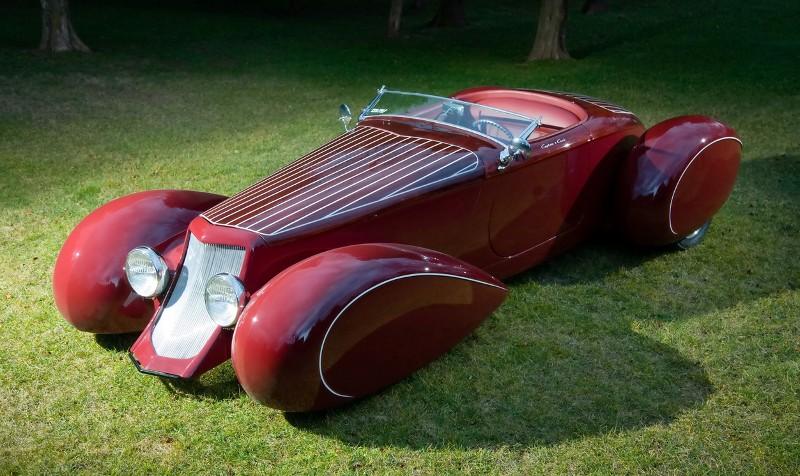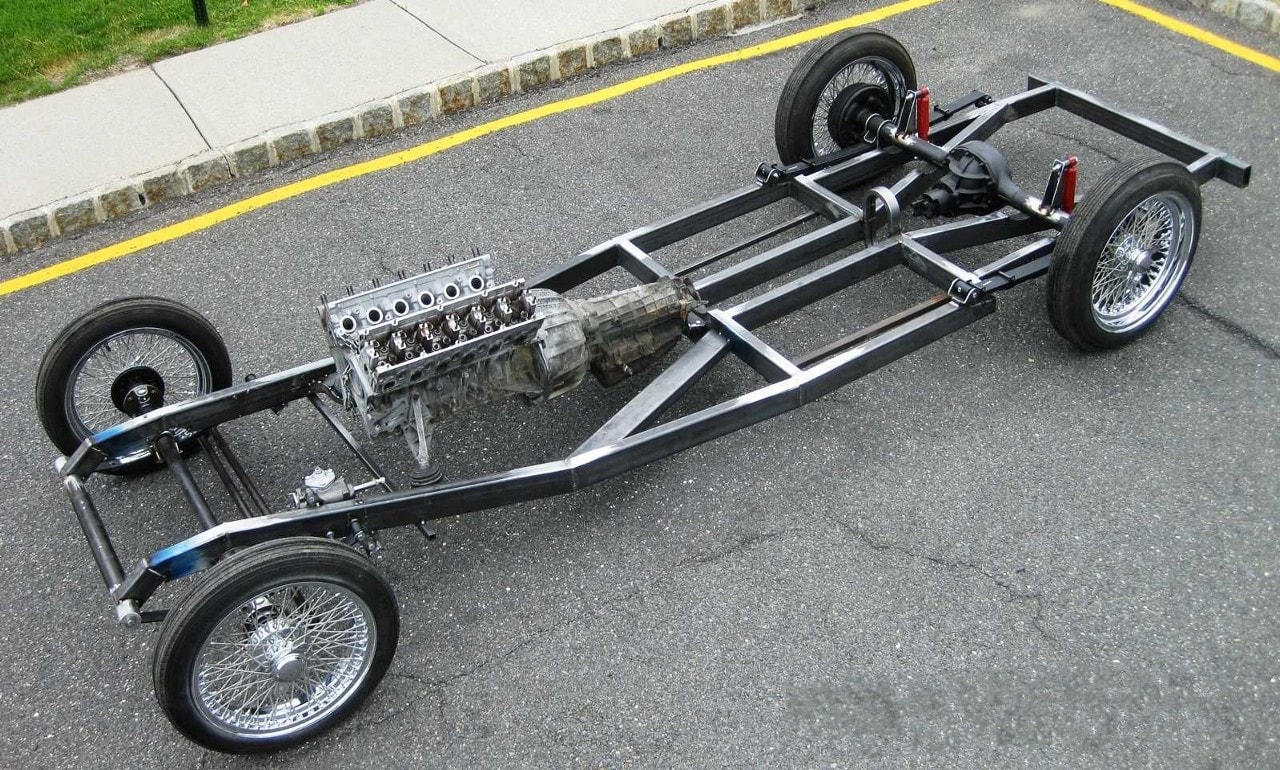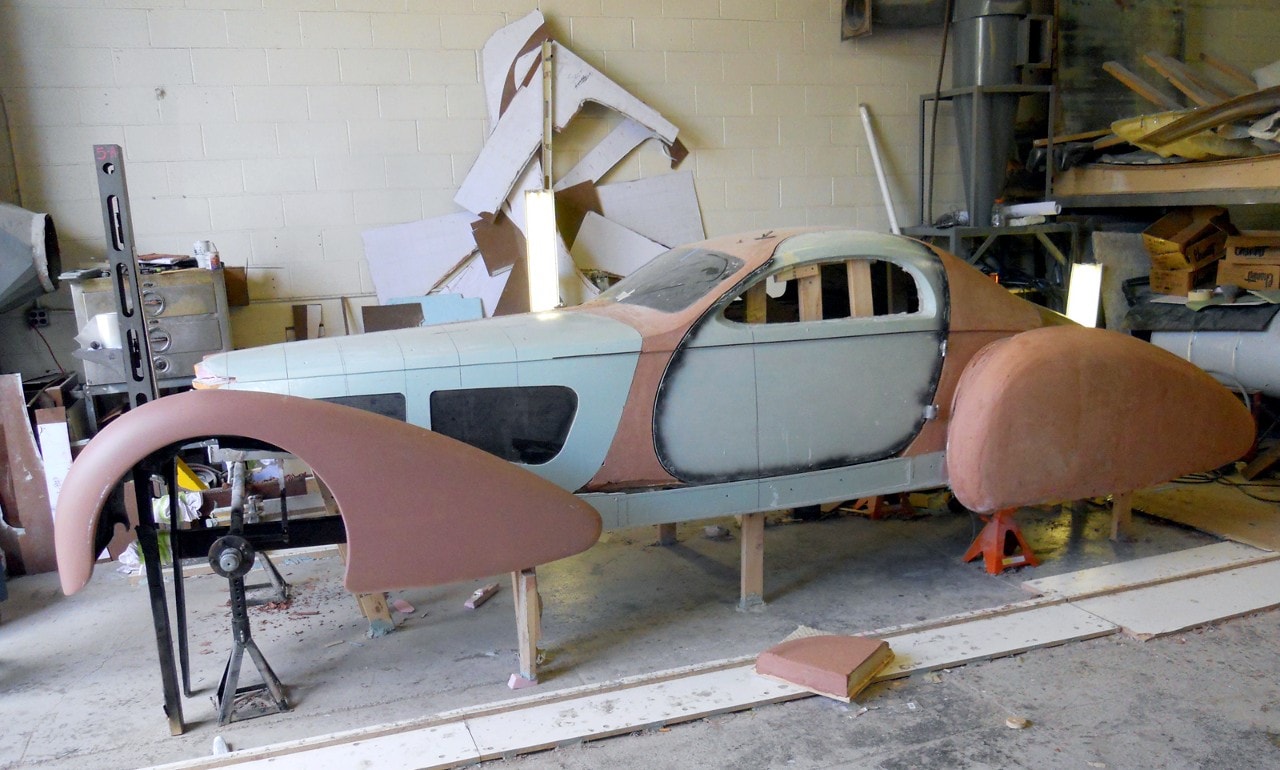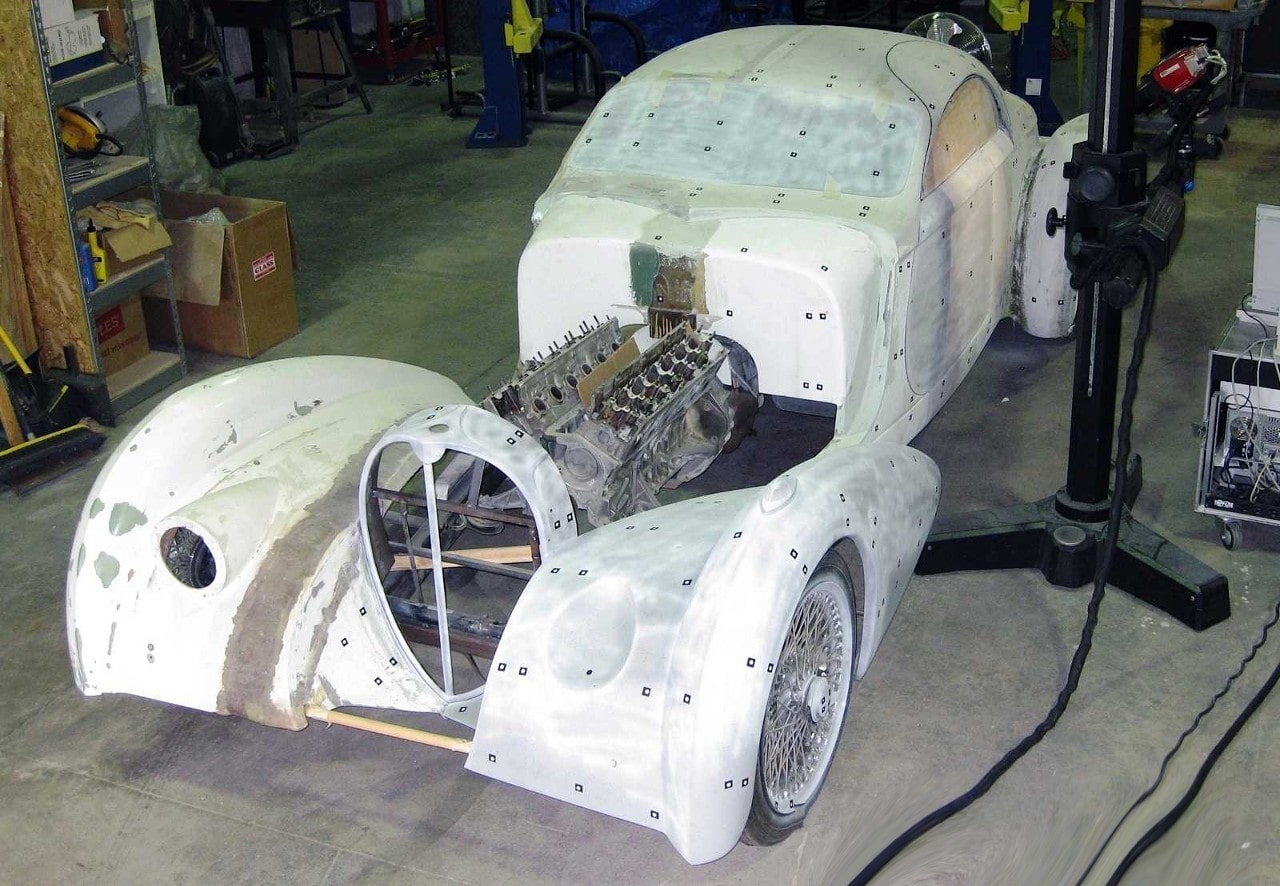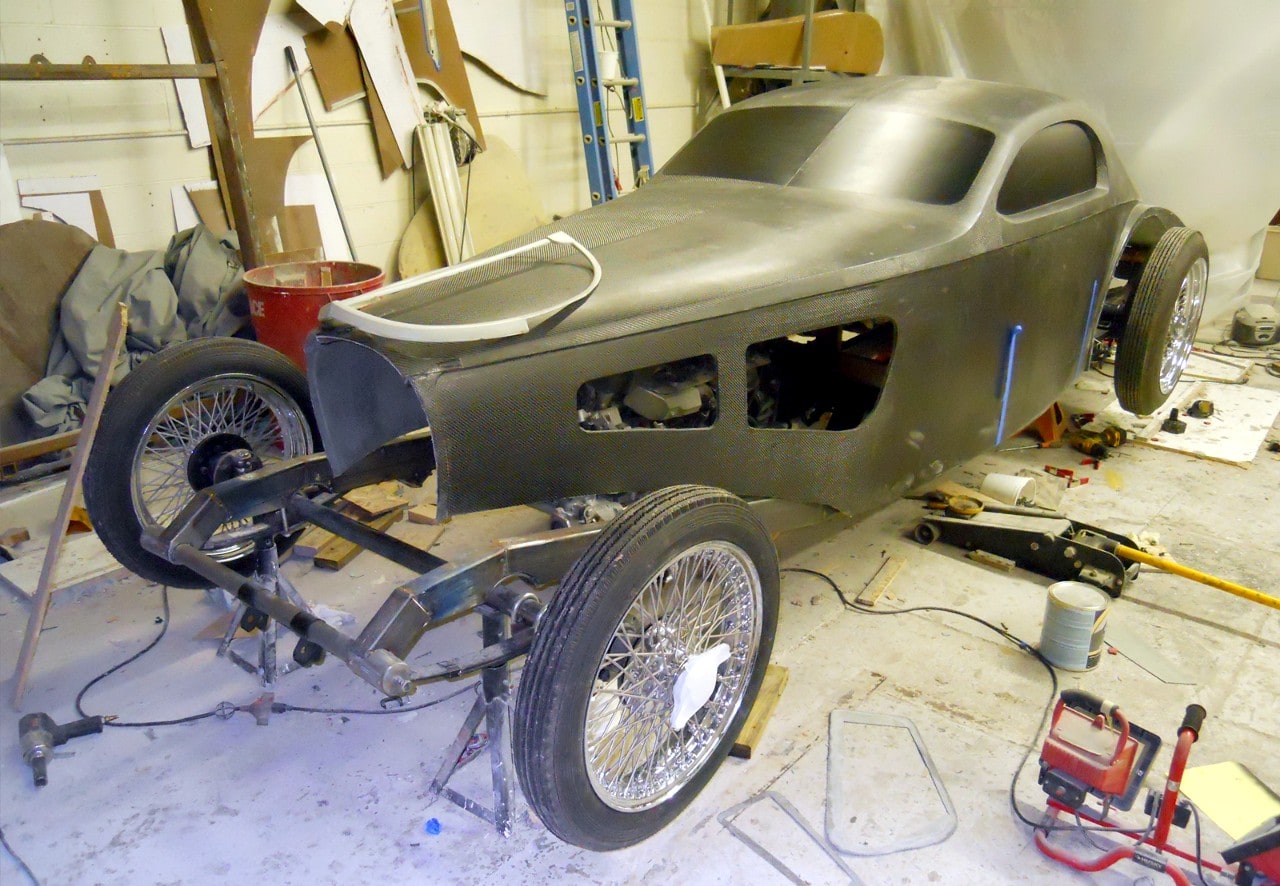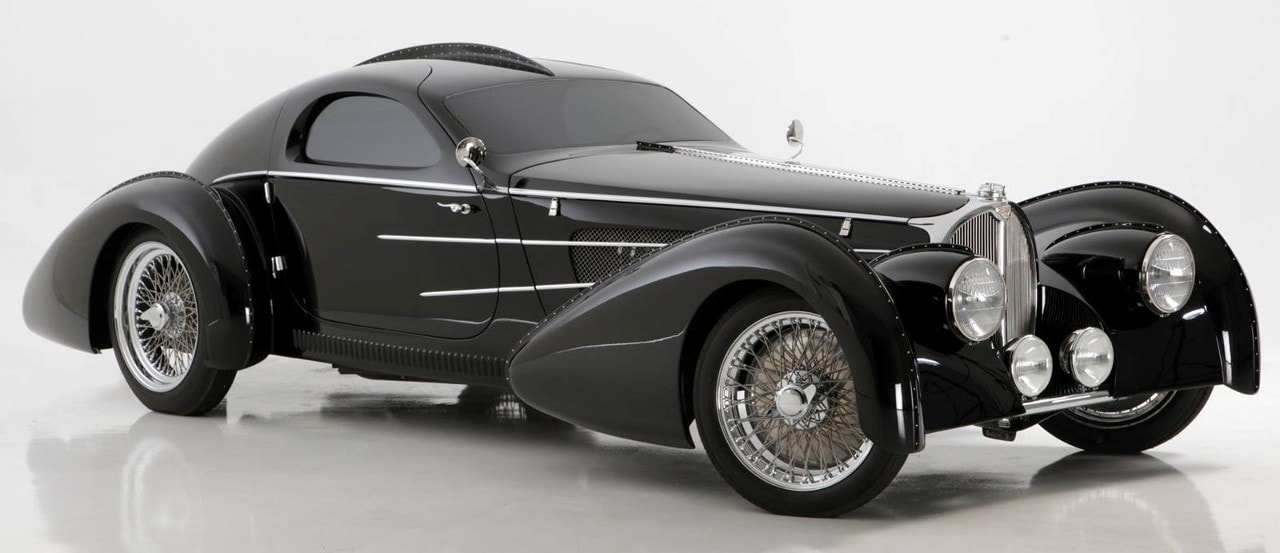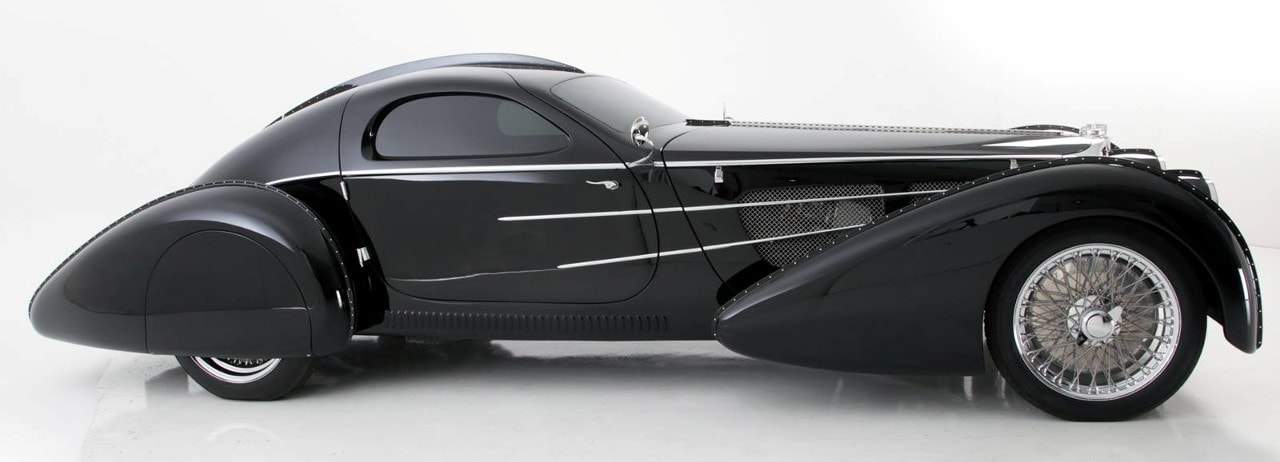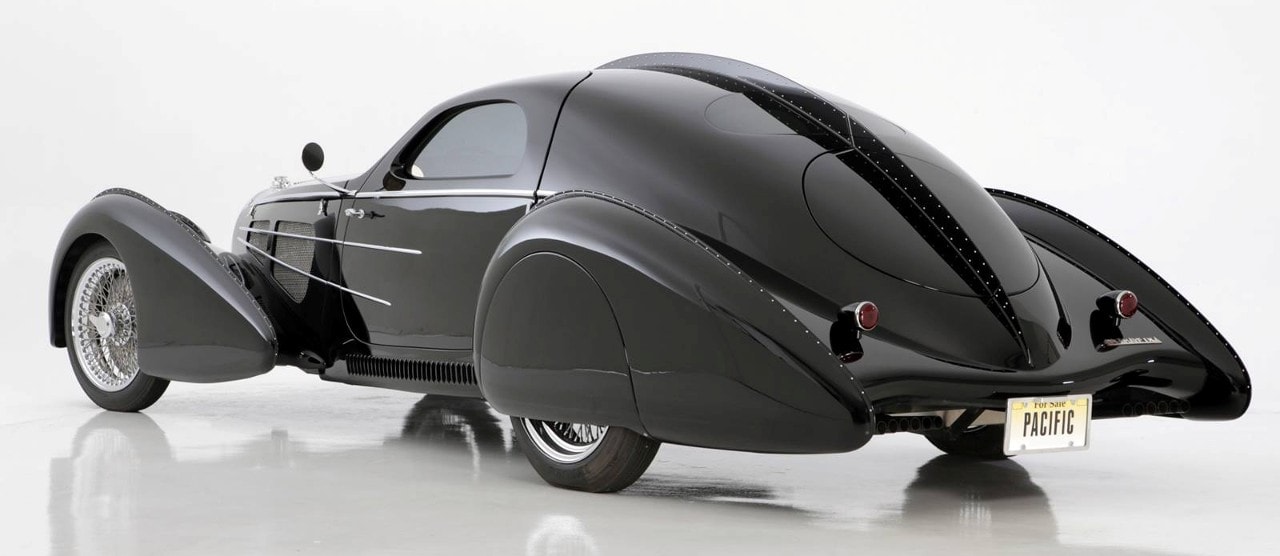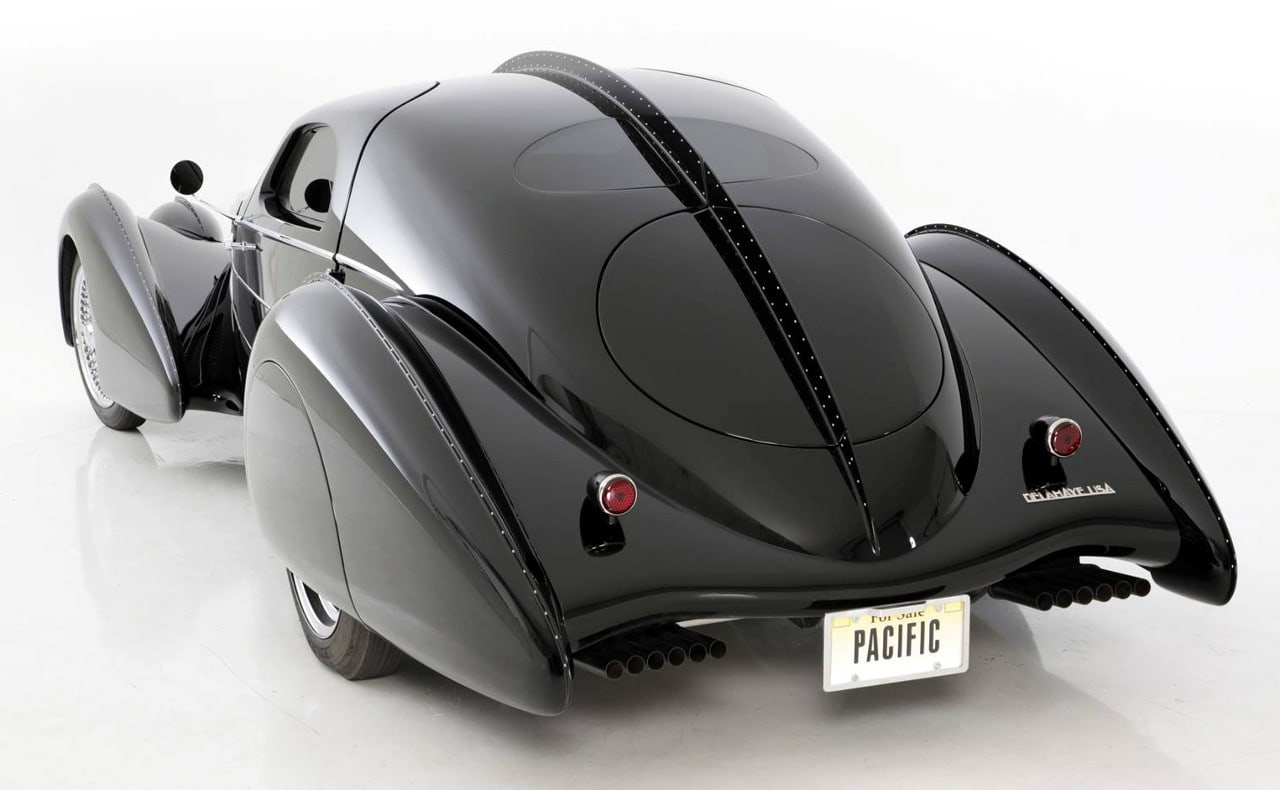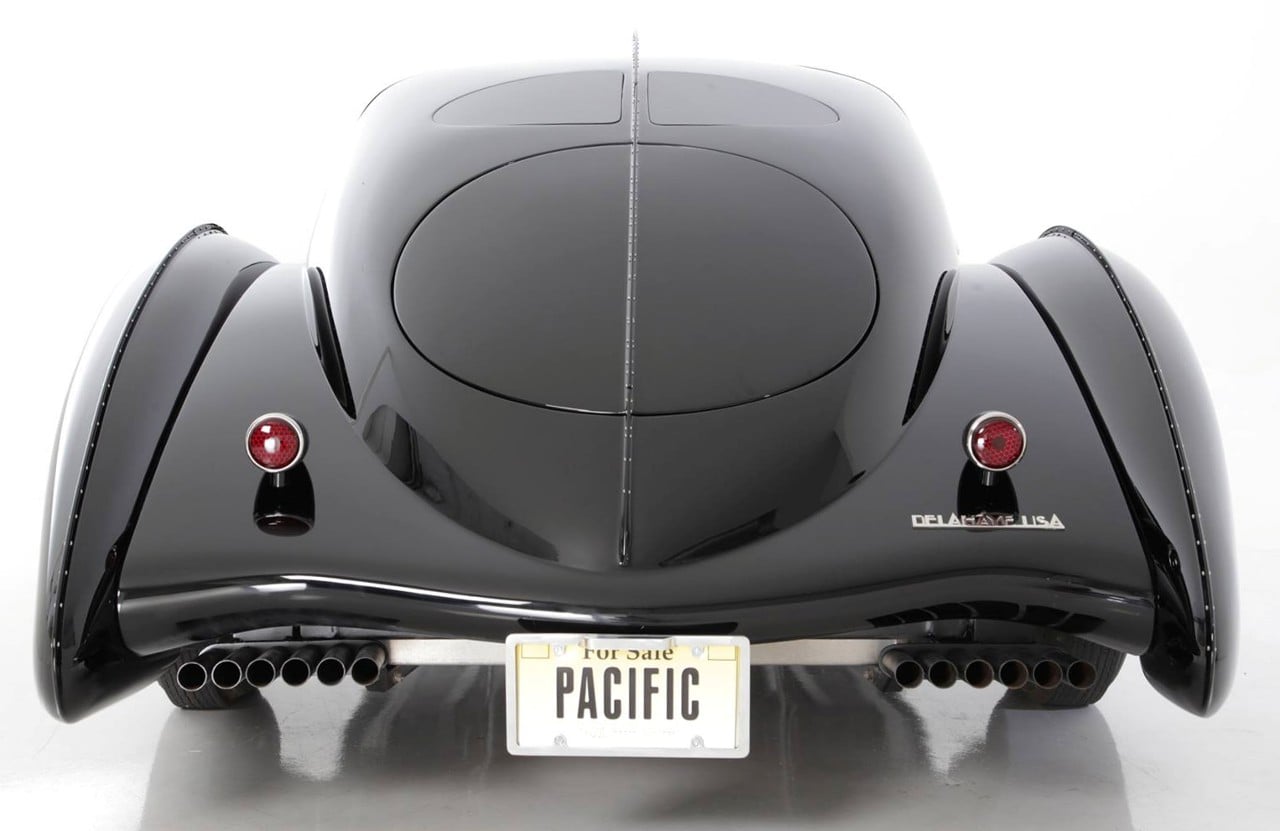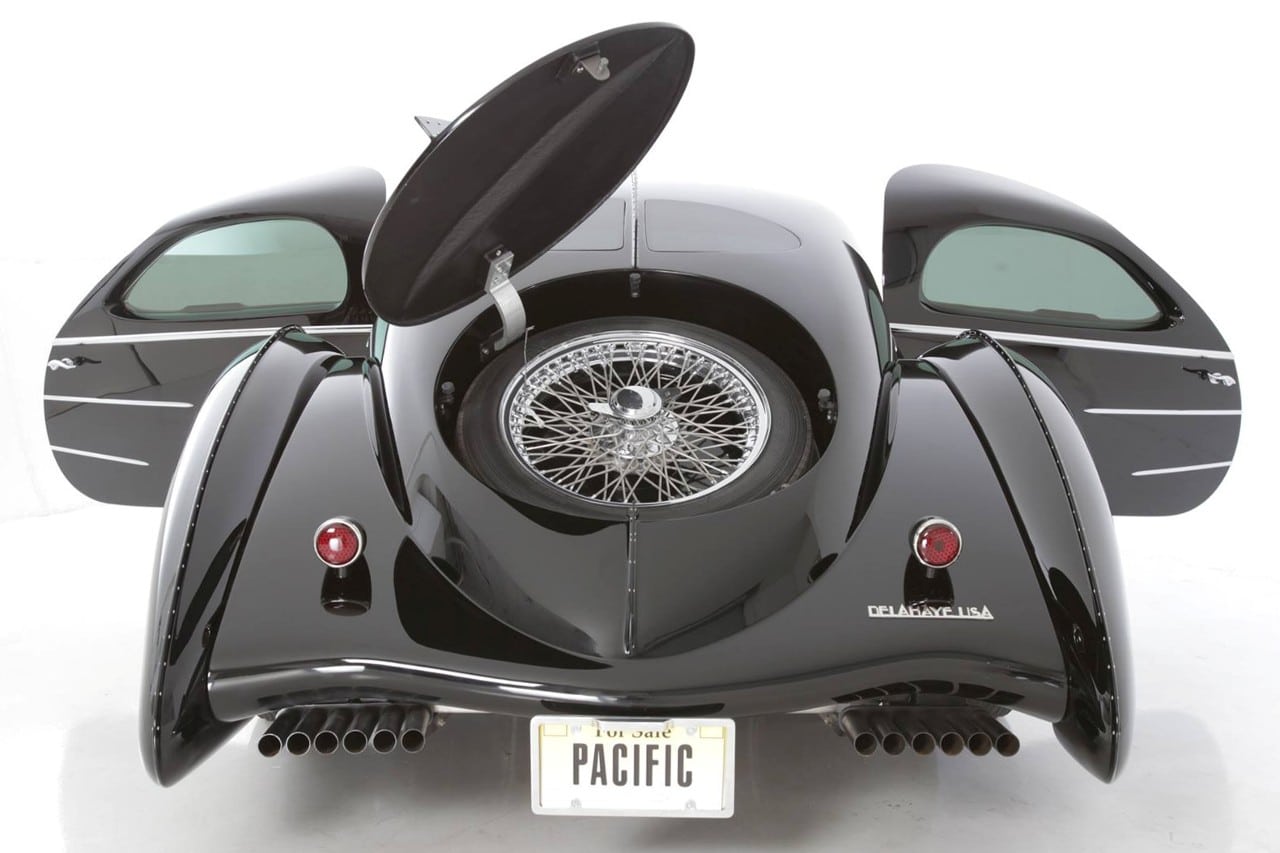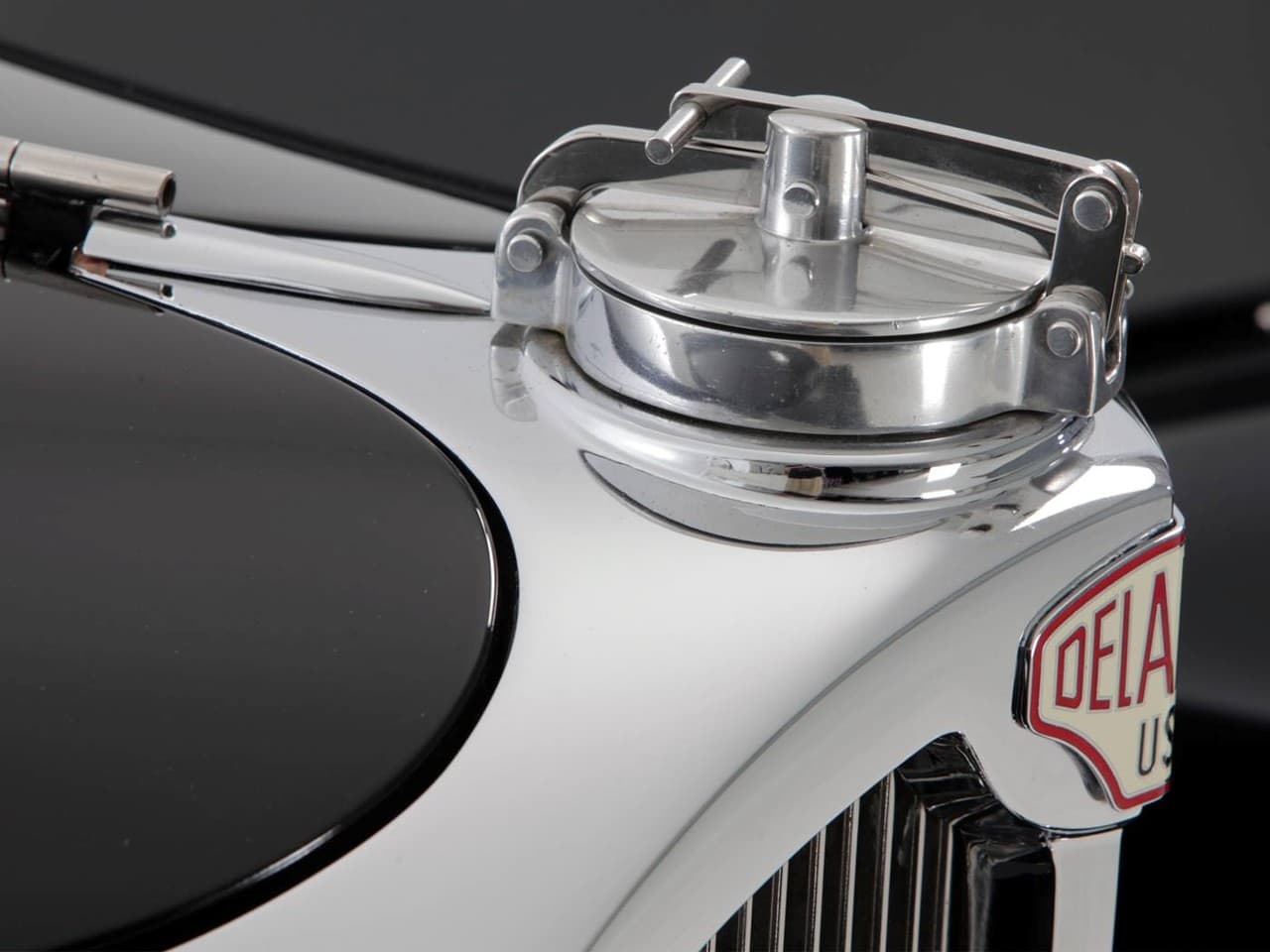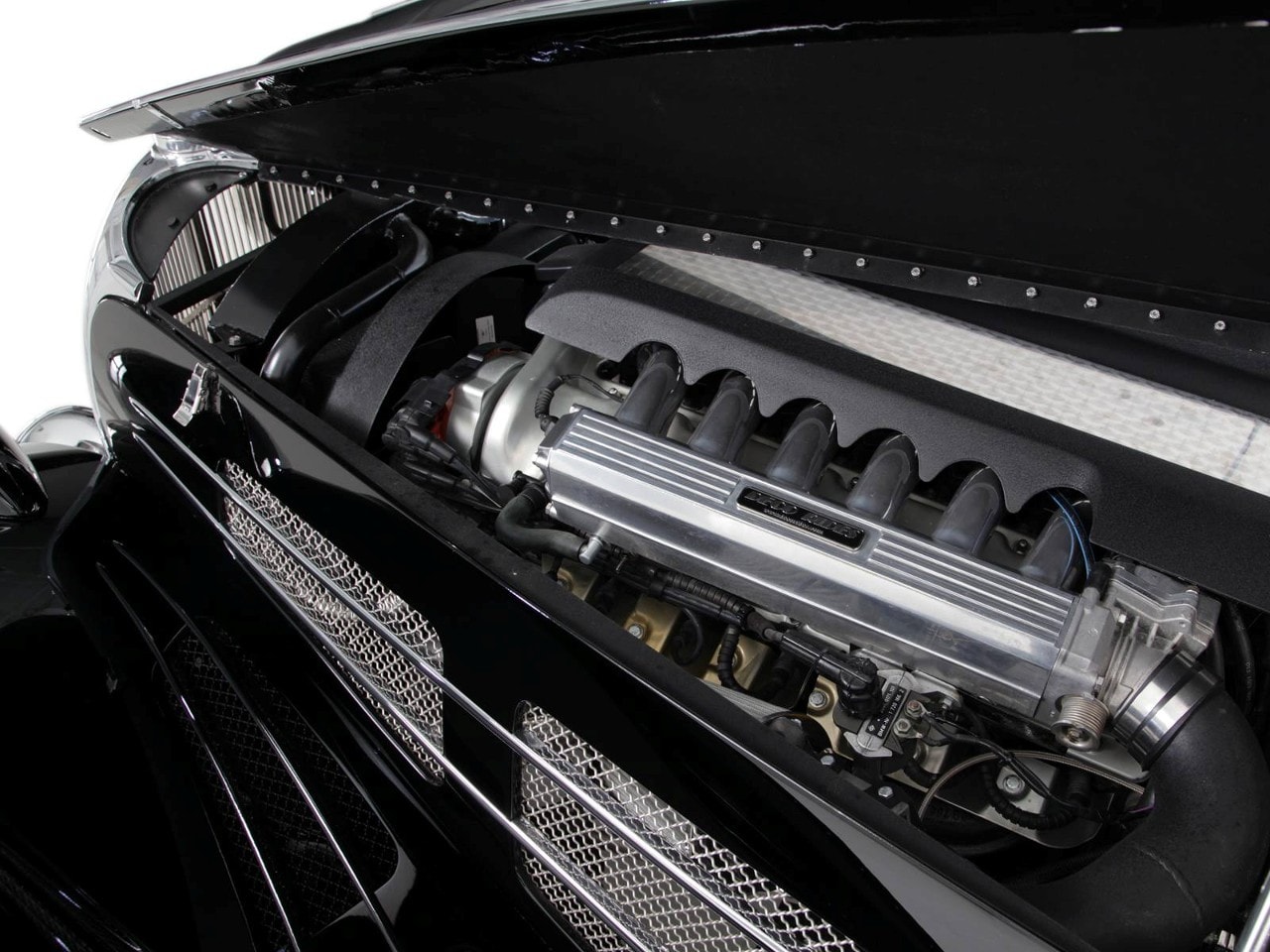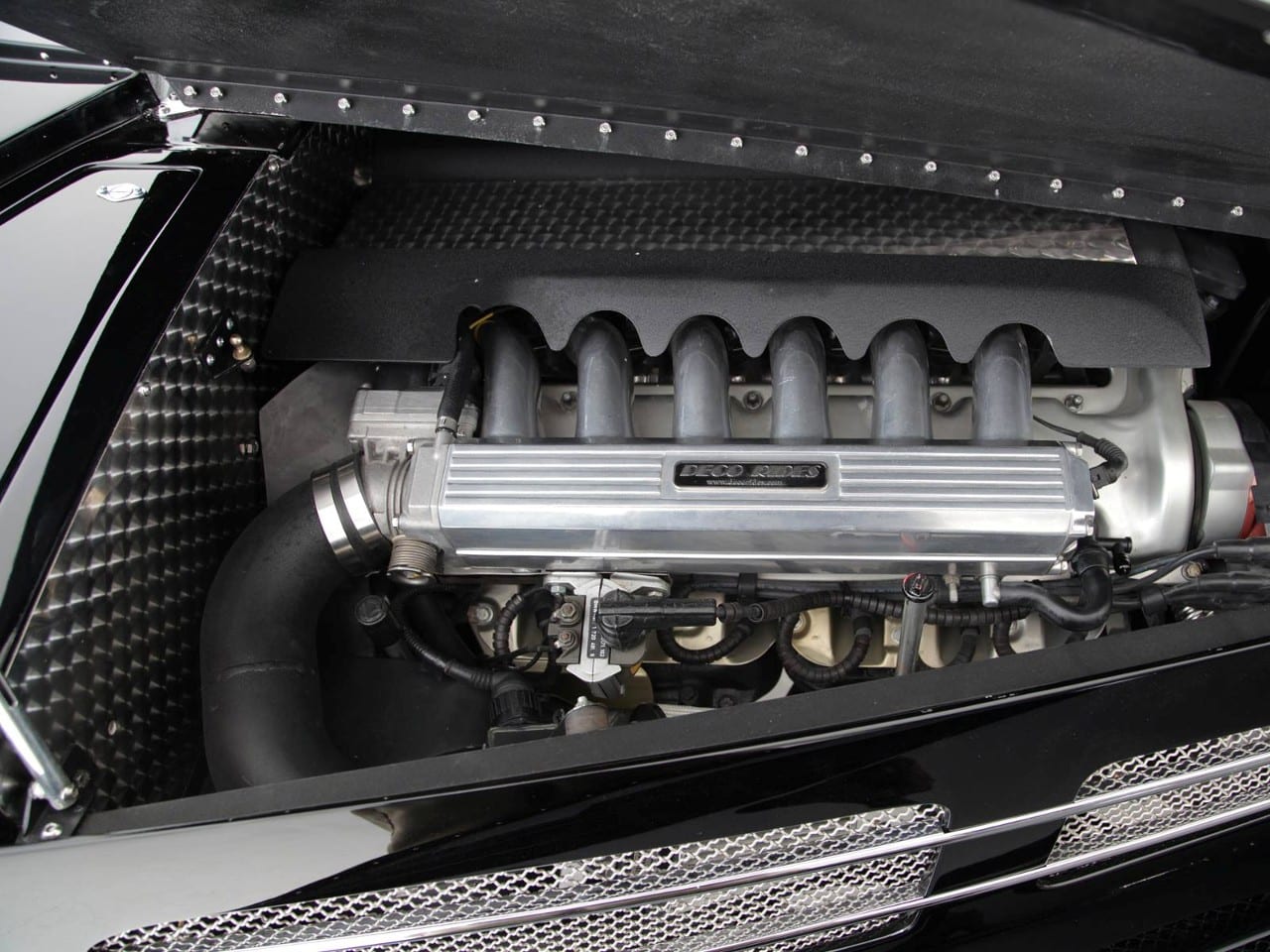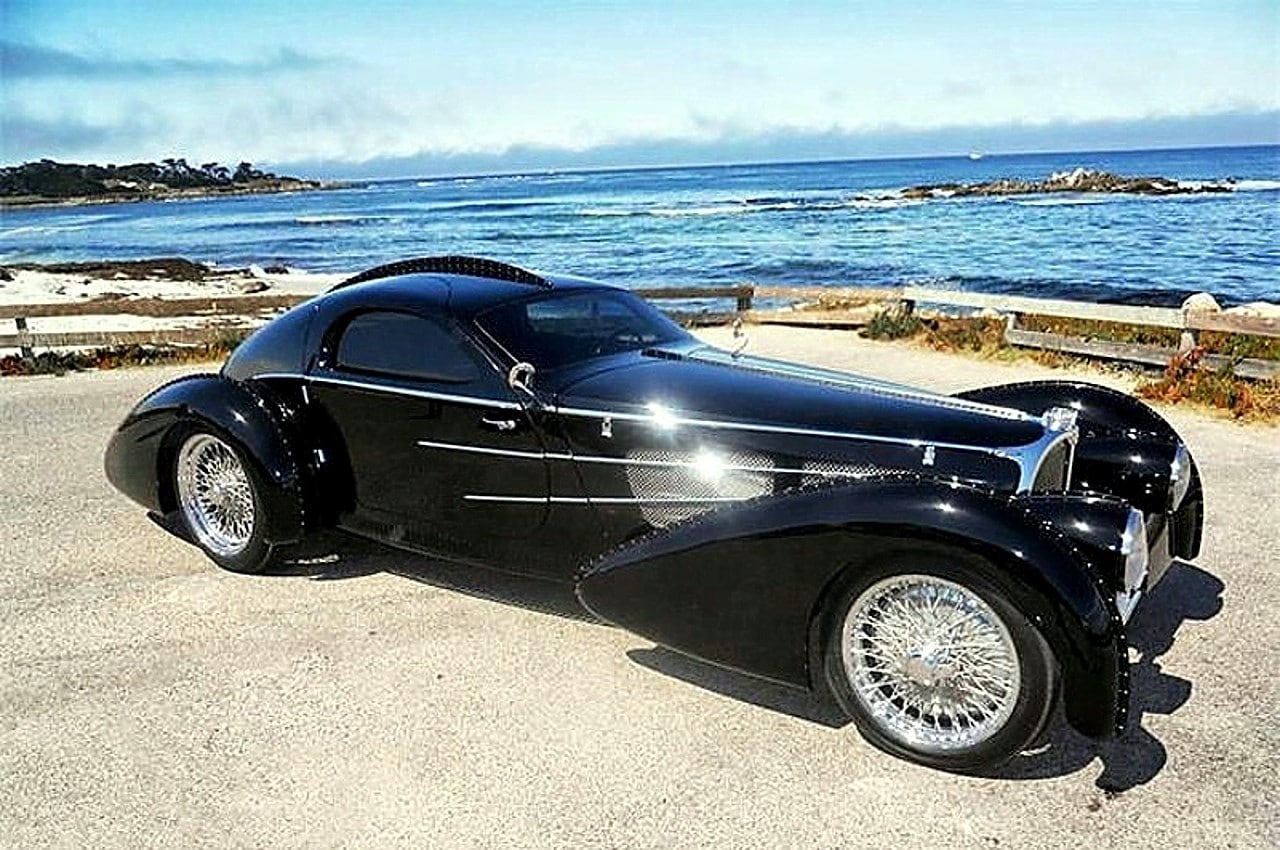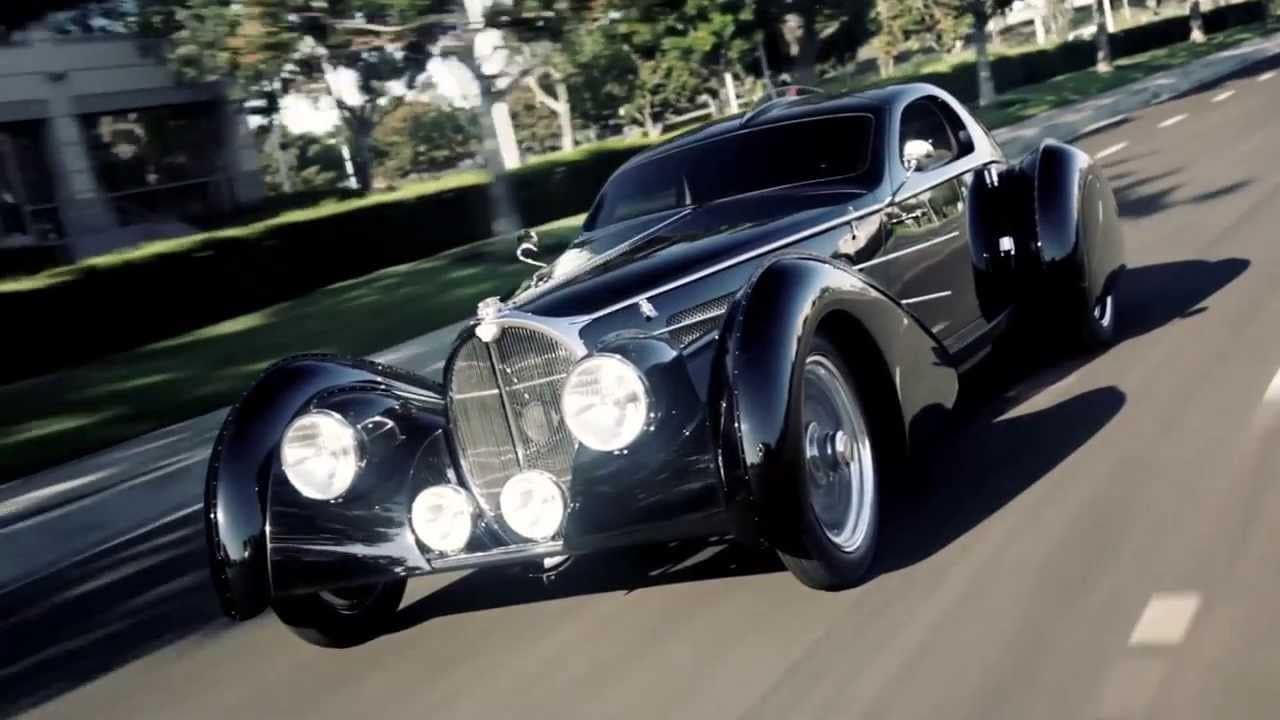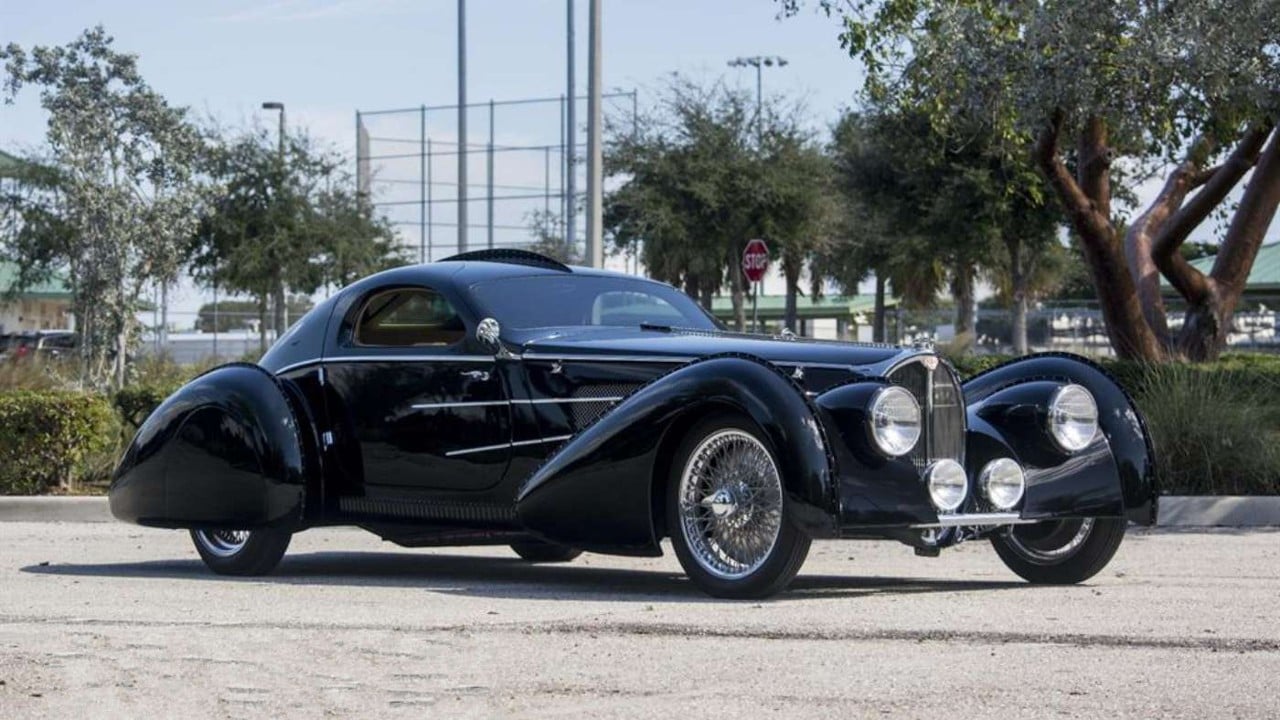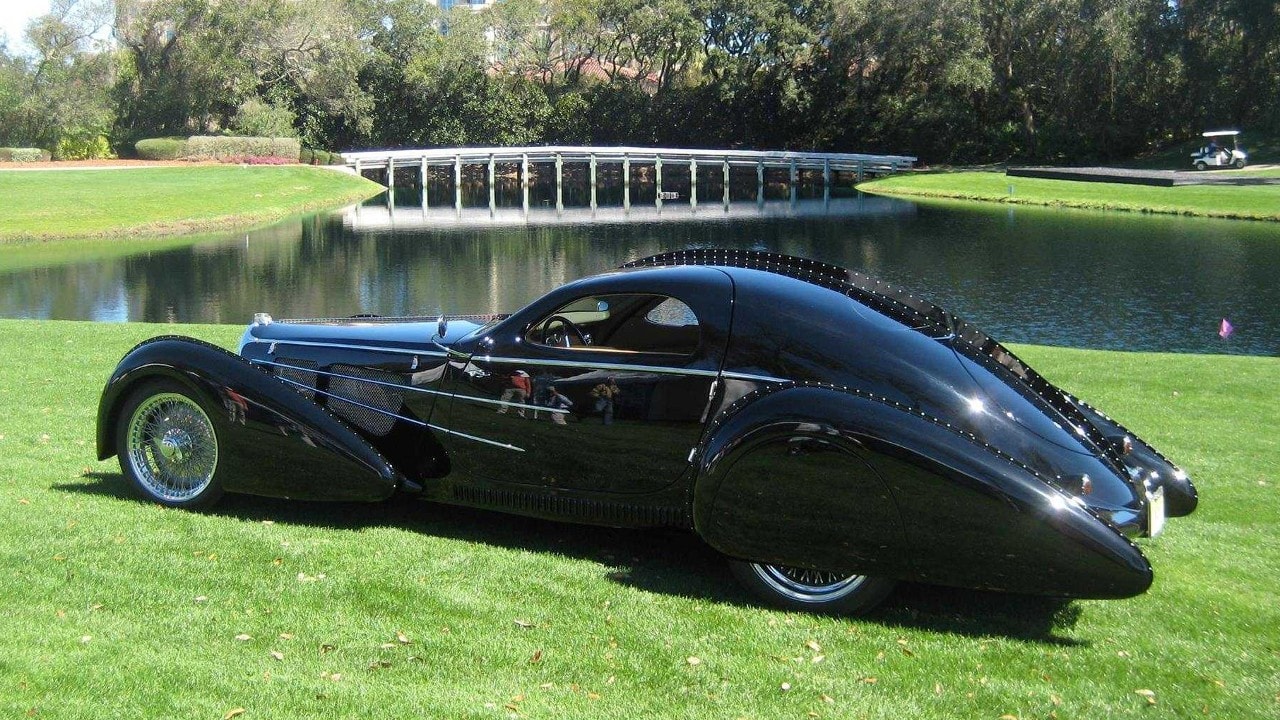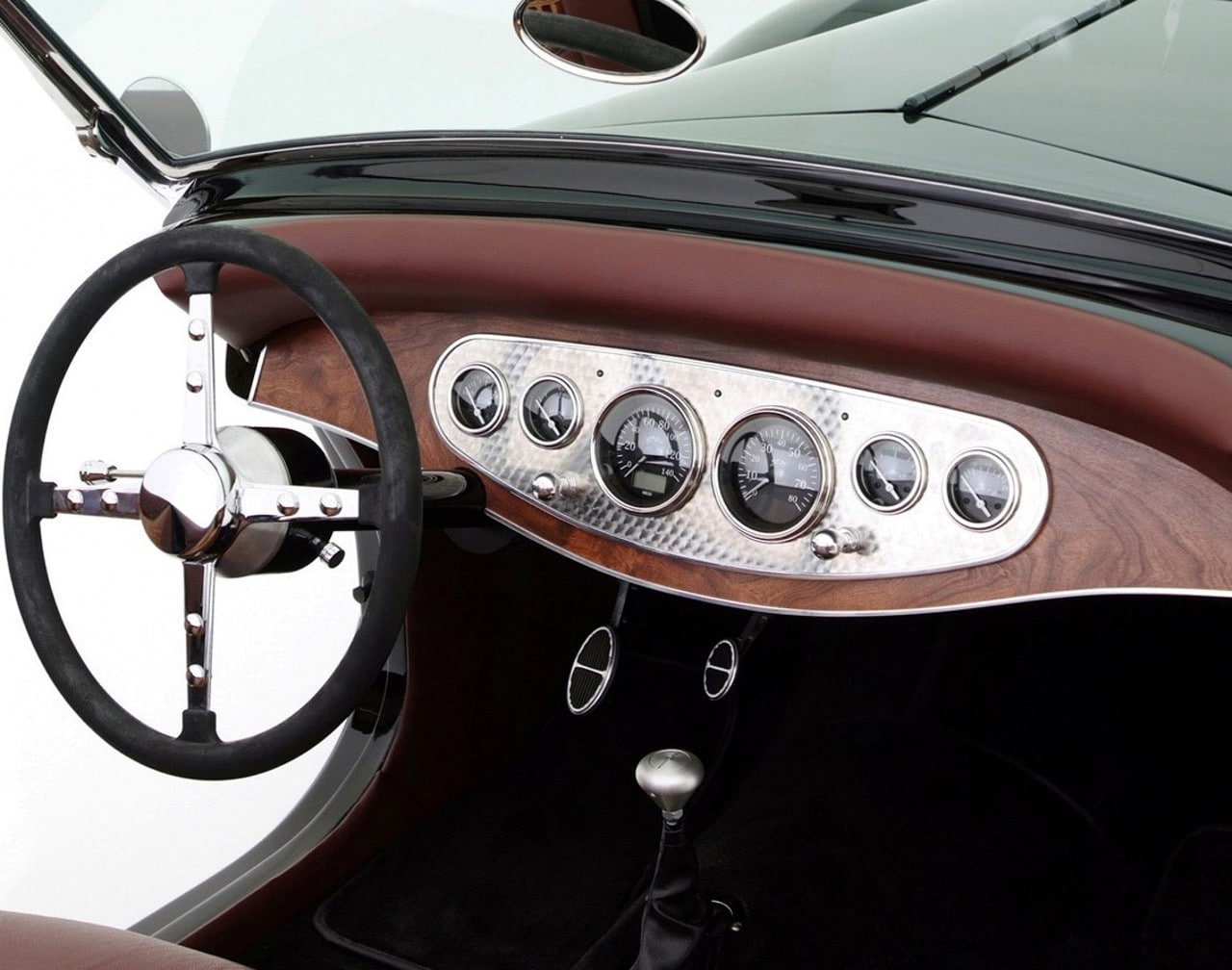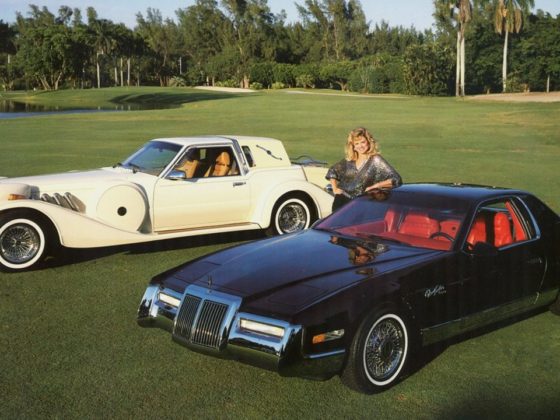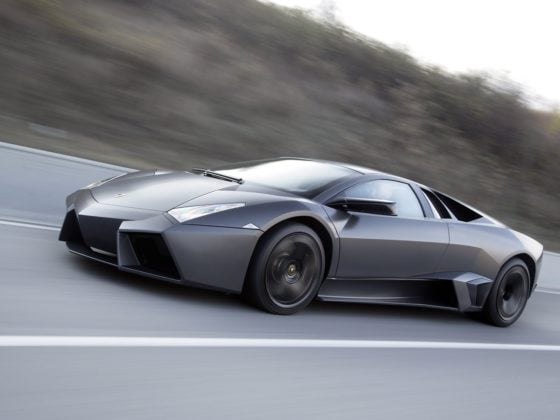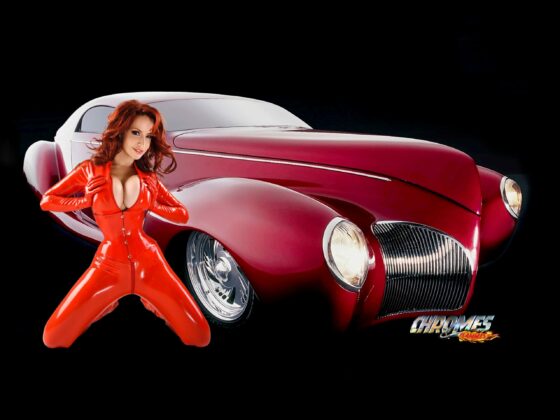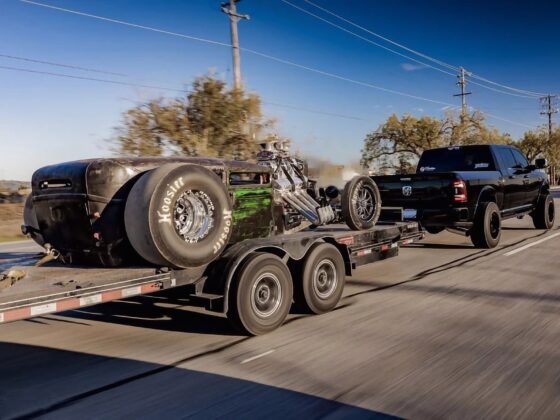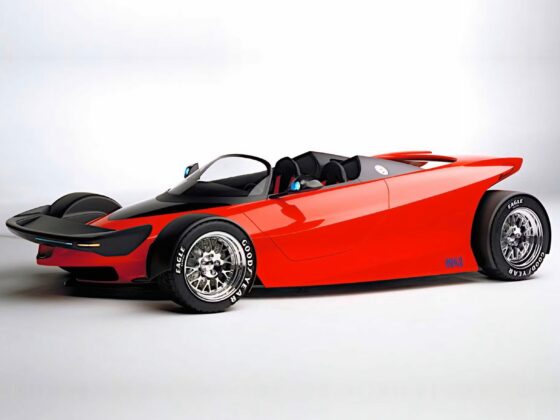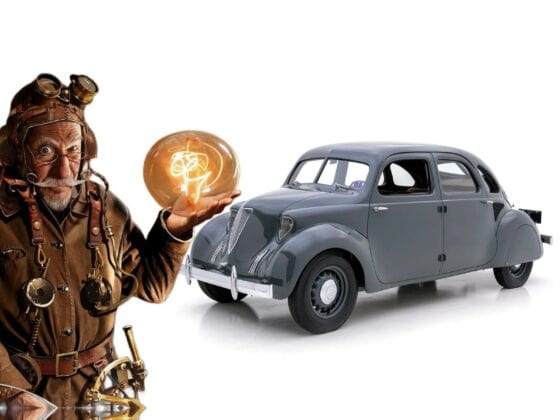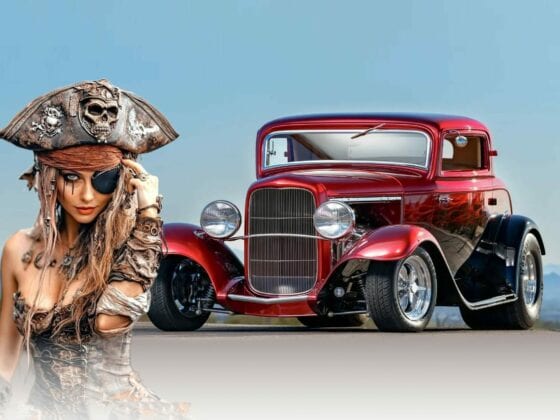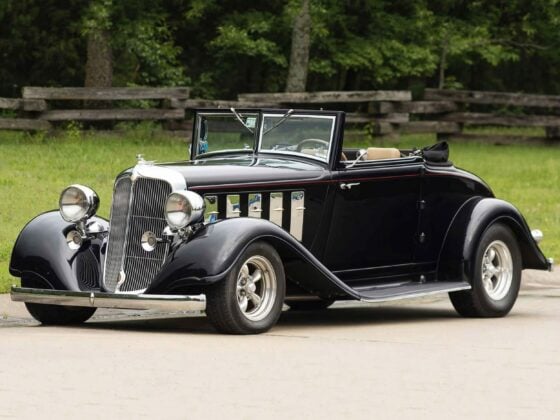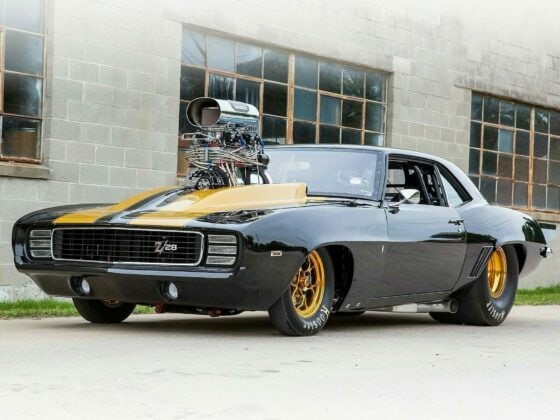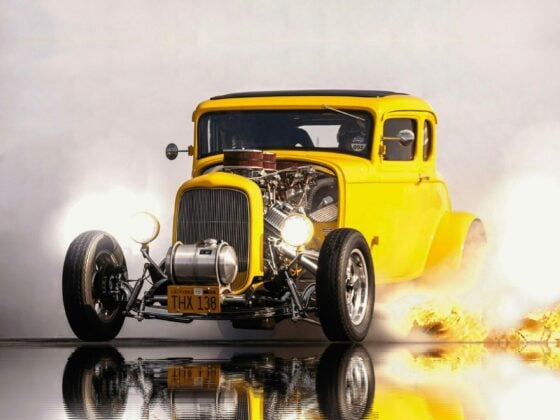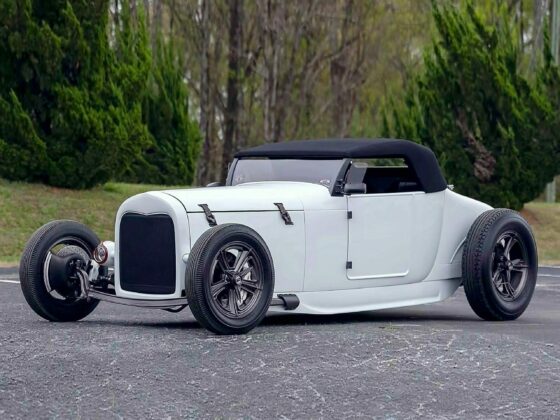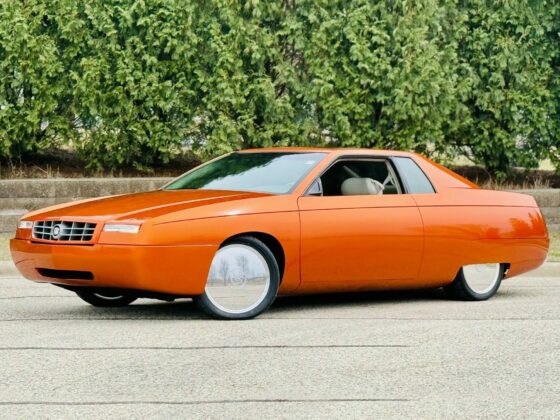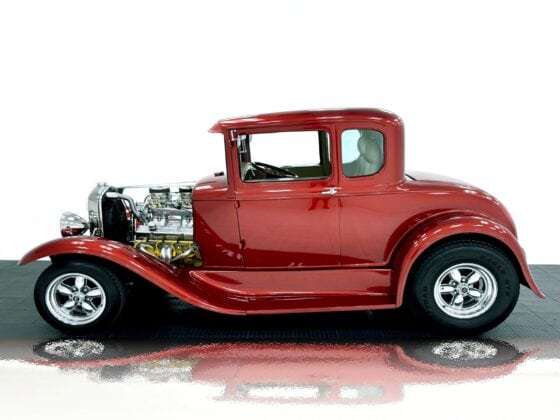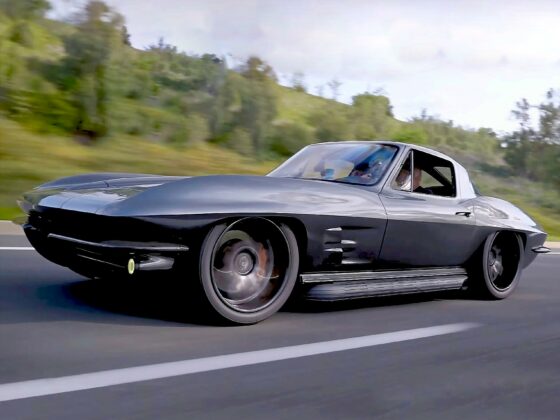Hot-Rod Figoni & Falaschi “Pontoon Fender” Generation One Boattail Speedster…
Going fast and big horsepower have never been my schtick.
To me styling is everything.
Cars like ’32-’40 Fords are unquestionably objects of absolute beauty.
But when I go to the Louisville NSRA Nats or the LA Roadster Swap Meet and see thousands of pre-war Fords, to me they are a blur of sameness.
Beautiful, yes, but essentially the same.
Been there, seen them.
Who cares if this one has a hand made calfskin honk baffle or platinum gritzial pivots?
They are often Xeroxes to the 16th power of some car done back in the late 40’s.
It seems everybody is reshuffling the same deck of cards, rehashing the same cars over and over.
Please, show me some sign of imagination and originality.
I have a long memory and a short attention span.
When I go to a car event or read a car mag I crave and search to see something that is different, yet at the same time looks “right“.
Like the fable of the KING’s NEW CLOTHES, usually the owner/builder can’t see the clumsy gaff.
We’ve all seen cars that are different but look glaringly wrong for one reason or another.
But show me a car, truck or bus that’s “right” which I’ve never seen before and it gives me a thrill.
The people who designed cars in the first place were gifted professionals and it’s very easy to screw up their work.
That’s all good as I love and savor all the neat old stuff tons more than I felt about the ill-fated “Pro Street” trend or bullshit in billet era of a few decades back.
Today’s rod movement is concentrating on recreating the past with patina finish and period perfect hot rods. And at the exciting no bucks/young rodder end of the scale, the Rat Rod/Jalopy thing is exploding.
My personal orientation with rodding is looking forward to the year 2040, not looking back to 1940.
It seems everybody is concentrating on hot rod history…. i’m not talking about 28-inch diameter wheels, I’m talking about totally new cars, with new styling.
What about possible future directions?
I feel like a one man Captain Kirk of rodding, going where no man has gone before with some of my cars.
The only problem is it can get lonely way out here on Neptune and beyond.
When you’re building a car that is not a classic and is so far removed from traditional street rods, you follow the path of your dream and suddenly realize you’ve distanced yourself from the masses.
When you go to create an entire car that is totally new and different, there is a high risk factor involved.
Peer pressure has always been paramount in street rodding.
What if the mainstream doesn’t like it?
Subconsciously people ask themselves, “If I buy/build this next project, will everyone approve of it and think it’s (I’m) cool?”
You have to have a passion for the project, and I’m totally passionate about the styling of certain classic coach builders of the thirties.
You have to be a charter member of the lunatic fringe to spend five + years of your life and way too many bucks to follow your dreams as I have.
My life’s quest is to find the best looking cars ever designed, and together with no money and a lot of perseverance, produce a classic that has been sliced and diced, hot rod style, that ends up looking “right“.
So what would happen if you combined those incredible lines with a “right” hot rod treatment?
Retired top Chrysler exec and visionary Tom Gale told me he felt the best cars ever designed were from the mid and late 1930’s.
I could not agree with him more.
John D’Agostino’s ’41 Packard Darrin, Mike Hudson’s orange Indiana-built Cord with fully enclosed and steering front pontoons and Roger O’Dell’s Figoni, Falaschi & Stanford inspired black and gold fastback 4-fender skirt ’39 Zephyr are three other examples of street rods with strong classic coach builder influence.
I’m not the only guy to look toward the future with “deco-flavored” (if you’ll pardon the plug).
Boyd’s recent Marcel-bodied Delahaye-flavored car for Scotty Weeks and Posie’s “Extremeliner” are two more totally scratch built cars that come to mind.
It took some serious cajones to build something that far removed from the mainstream.
They were on target, each was unique and they looked “right” for the most part.
Five or six cars do not a “movement” make, but are signs that some guys are bold enough to break out and go in fresh, new (old) styling directions.
I’ve always been in love with the early and late vintage Auburn Boattail Speedsters, and on page 49 of the Summer 1998 issue of The RODDERS JOURNAL was a small sketch of an Auburnesque Boattail Speedster.
The body would have to be built from scratch but the front and rear fenders could start life as “bobbed” fiberglass versions of the stock Auburn.
It motivated me to have a buck and molds built for my next project.
At the time I was eyeball deep in making fiberglass SCRAPE-based Zephyrs so a natural goal of Project Boattail Speedster was from the start destined to end up with another set of molds.
For the record, the Deco Rides Boattail Speedster is clearly not an Auburn, it was just influenced by one.
To make molds you need a good plug (a.k.a. “buck” or male mold).
Where we took glass molds off SCRAPE, I needed to have a full sized Boattail buck built from scratch.
Herein lies the challenge.
This involves building a buck from scratch by hand using plywood, blocks of foam, many very large buckets of bondo and literally years of rubbing and loving to achieve the desired shape.
There are modern ways to accomplish this end using models and computer controlled (CNC) 5-axis milling machines, but being bucks limited, I was forced to do it the “old” way.
I’ve never been a builder, per se.
The first team I enlisted to build the buck was Rob Ida and company from Ida Automotive in Morganville, NJ.
I consider myself a visionary with an American Express card and a serious addiction problem (building fantasy hot rods that are planets away from the hot rod mainstream).
Three months and $25,000 later I decided to pull the project, a rough plywood buck, out of their shop and find it a different home.
The Zephyr job went elsewhere but I decided to try Mike Ball of Lake Webster, IN, son of Gary Ball of (then) Ball’s Rod & Custom fame in Syracuse, IN to carry on with the Boattail.
I had been investigating 20+ different fiberglass shops around the country in what seemed like a never-ending quest to find a reliable vendor to produce high quality Zephyr bodies.
It was good decision.
He also had a good sense, feel and understanding of style, adding his seasoning to the design.
Mike is to be commended because he kept his word regarding the price he bid on the job and did a decent enough job on quality and symmetry (considering it was a hand/eye job).
The problem was that it took 18 months.
By Oct. 2002 when I picked up the molds and first body from Mike I was four plus years into the project and growing impatient.
I’d give him a thumbs up or down on the design direction he was heading, tell him what I wanted in design refinements and slip him another check to keep him on the project.
I lost count of the round trips I made driving from NJ to Northeast Indiana to inspect Mike’s work.
After Indiana, I took the molds to Arkansas to have the molds strengthened.
I took the bondo, foam and plywood buck in primer to the Louisville NSRA Nationals to sit in the DECO RIDES booth along with a Zephyr sedan delivery buck and a Zephyr convertible roller.
At one point in 2001 we took the buck down off the jig, assembled it, got it rolling on four wheels.
That was the first time in a year of work we ever put the car together, rolling on wheels, and we stepped back to see what we had wrought.
With sc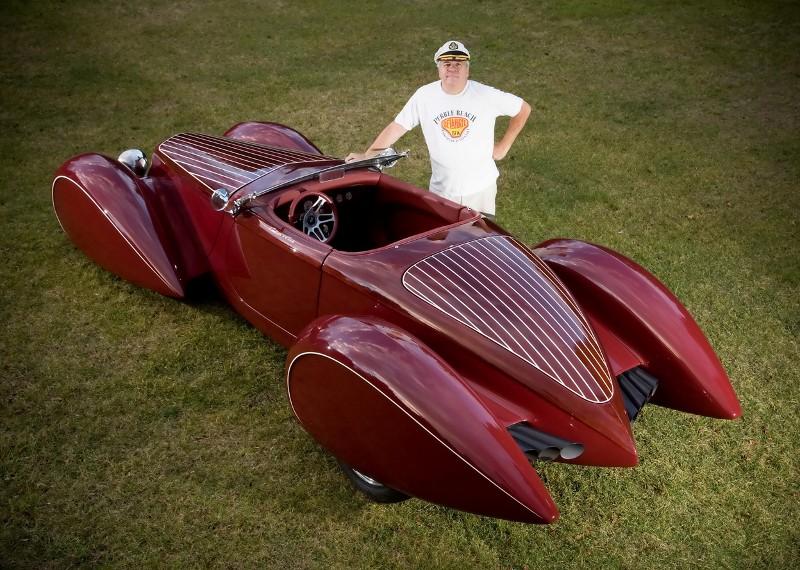 ratch built projects you have to put it down on the ground and step back and walk around it from a distance and photograph it to see where you are. It gave us an opportunity to get the public’s reaction and seek out critiques of what we were doing.
ratch built projects you have to put it down on the ground and step back and walk around it from a distance and photograph it to see where you are. It gave us an opportunity to get the public’s reaction and seek out critiques of what we were doing.
I also was curious to know what all the “lemmings” with ’32 Fords would think of it.
I was trying to find out specifically if and where the design was bozo or wrong (and how we could fix it).
I always say that to make a car beautiful, you just keep rubbing on it until all the ugly spots go away.
Hopefully you can see the ugly spots like a flashing red light, but sometimes they like to play tricks on your mind.
This is a big mistake as it makes the fenders look like they are splayed out, moving away from one another in perspective.
During the rolling buck stage I also noticed that the peaks on the rear pontoons were relatively parallel to one another.
I had Mike rip the pontoons apart and “hook” them toward each other as they swept back.
I’m still not totally happy with the rear pontoons, but they are far better than they were.
When the first glass body was out of the molds I took it, the wheels, and a Viper engine and manual transmission to Fat Man Fabrications in Charlotte, NC to have them build the chassis.
I selected a Viper because I felt the car needed something flashy, different and noteworthy for motivation.
I picked Fat Man because they had been building Zephyr chassis for my customers and had been doing a super job.
They know what they’re doing, and they do what they say they will.
Where searching for reliable and honest vendors who know what they are doing can be a real challenge, working with the guys at Fat Man was a pure delight.
Special thanks to Bubba and “the real” Kevin.
Somewhere along the time line I wondered what the car would look like as a highboy.
Side view sketches didn’t answer the question but when we put a set of Colorado Custom 20-inch rear and 18-inch front wheels with tall tires on the body and rolled the chassis outside the shop without a front nose section, ZOWIE, it “worked” as a boattail.
As a joke I had Darrell Mayabb do a color rendering of the highboy with woodgrain top surface and white speedboat calking.
He also did a fully enclosed four fender Joe Figoni fastback sketch at my request.
Love them swoop coupes!
One of the few things I built on the car (with the help of Ramsey Mosher in Dover, DE) was a prototype lift-off fastback roof with Lamborghini Muria-style rear window louvers.
Both are on my “cars I wanna build” list and now, with the help of Rich Brendell in Hudson, FL, I’m building the “Chris Craft” highboy with real wood veneer laminated onto the upper body surface.
In addition to showing the buck at Louisville 2001 and Detroit Autorama 2002, I exhibited the primered fiberglass prototype body in my DECO RIDES booth at the Goodguys TX and KS events, at Atlantic City plus York & Louisville NSRA in ’03.
I had it on my website and passed out/mailed out better than 5,000 brochures.
Reaction ranged from rodders walking right by it without giving it a second look to people proclaiming it was fantastic and futuristic.
But only one guy gave me a deposit for a body, and he was from Australia!
Walter Ulrich was the key man.
It was the team at SPEEDSTER MOTORCARS in Clearwater that is to be credited with taking the 3/4 finished Boattail to completion.
In addition to prepping the car for paint, they squirted it HOUSE OF KOLOR pearl tangello with white scallops and body insert, chased with a white pinstripe.
This paint scheme was strongly influenced by the Leamy-bodied Boattail that presently sits on the mezzanine level of the Auburn-Cord-Duesenberg museum in Auburn, IN.
Brake lines, Ostrich leather upholstery, fuel lines, getting the engine running, radiator, etc. were all done in Clearwater.
A Kugle dual hydraulic pedal setup is used.
The windshield frame is a Cam Grant Duval that Ramsey Mosher modified according to suggestion, kicking the A-pillars parallel rather than leaving them splaying outward as they swept upwards.
Don “The Egyptian” Boeke etched a numeral 10 in the Glen Pray repro AUBURN taillight lenses, a Viperized mimic of the original AUBURN 12 lenses.
The grille was made by Alumicraft and the grille shell started life as a fiberglass Auburn Boattail nose that was severely laid back, chopped, sliced and diced.
It is NOT a ’34 Ford grille shell as some rodders think.
The stainless exhaust system built by Borla East in Lebanon, NJ is on the trick side.
It utilizes the stock Viper headers, but the pipe Y’s just after the collectors.
One branch leads through an electrically controlled slide-valve exhaust cutoff, then into a four foot dump that exits unmuffled exhaust out under the rear door jamb.
The other branch leads through a muffler to a collector box hidden under each rear wing.
Ten mini-fishtails built by Ramsey Mosher tuck out the back of the car.
Touch a switch to open and close the slide valve on the idling parked car and watch the fun.
Muffled to straight pipes, and back to muffled in seconds.
“It wasn’t me, officer!”
However for the sake of making the car more “fathomable” to the masses, I decided to open up and cut out the rear wheel well to expose the rear tire.
Originally the car was designed with enclosed rear “pontoons“, a Figoni & Falaschi influenced style I love.
I figured John Q. Rodder was not yet ready for enclosed rear pontoons.
I cut the radius for the rear wheelwell opening centered on the rear axle, which seemed to be a natural design decision at the time.
The car was originally designed with a set of low profile BFG 295/40ZR18 front and 295/45ZR18 blackwalls mounted on billet wheels, which in some of the photos reside on the driver’s side of the car.
At SPEEDSTER we speculated the car might be more marketable with wires and wide whites, (especially in light of the “circus wagon” orange and white with white scallops and pinstripes paint job) so P205/60R15 front and larger P275/60R15 rear wide whitewalls mounted on Cragar chromed wire wheels ride on the passenger side.
The “pimp side” (wide whites) beat the “hot rod side” in public polling by a 9 to 1 margin.
This is an old SCRAPE trick, since you can only see one side of the car at a time.
At the outset I spoke about the car (and my tastes) being distanced from the mainstream of street rodding.
Being so different, I wondered if the car would be accepted at rod events.
When it was completed in summer 2004 I exhibited the car at Goodguys Indy (2 hours on Sunday), the SoCal party in Pomona, the LA Roadster’s Father’s Day Swap Meet, the Long Beach Swap Meet, the Concours on Rodeo in Beverly Hills and at the RM Auction in Pebble Beach.
I’m happy to report that reaction was positive and powerful.
In general, however, the concours crowd appreciated the car more than the “white bread” hot rod crowd.
It amazes me how rodders walked by the invisible Viper-powered Boattail in primer at York and Louisville yet clustered around the painted car in Indy, Long Beach and Pomona.
Despite the fact it went across the auction block at 2:00 AM when all the bidders had gone home to bed, car collector and Five Star Ford dealership owner Sam Pack of Carrollton, TX paid $137,500 for the Boattail.
You should see his collection!
I have some unforgettable memories of driving that car.
Like most of my creations I’m glad I sold it because that allows me to move on with several other projects I could never otherwise afford.
I parked it right off Ocean Avenue in Carmel on Thursday of Pebble Beach week when the tour cars were stopped there for lunch, I drove it down Highway 101 and saw the spectacular ocean view as I approached Monterey, and I experienced “the tunnel” with my pal and “agent” Riley Hopkins of Gig Harbor, WA.
Next to the Doubletree Hotel at Fisherman’s Wharf there is a long straight tunnel, two lanes going one direction in one tunnel and two lanes going the other in the second parallel shaft.
The deal is to lag back so all the traffic drives away from you leaving the long stretch of tunnel open and empty in front of you.
Then you reach under the dash and hit the switch to open the exhaust to straight pipes, start rolling in 2nd gear and get on the throttle.
The exhilaration of acceleration for 1/8 mile compounded by the sound of that outboard-motor-sounding Viper with straight pipes echoing in the tunnel gives me goose bumps just to write these words.
Memories.
Just havin’ fun with cars.
Life is good.
If that name sounds familiar, born in 1942, Terry was a member of the Squires of Chatham.
Who is Terry Cook?
NJ hot rod club before he got his driver’s license.
He was the flag starter at Island Dragway in Great Meadows, NJ when it opened in 1961.
He wrote a column for DRAG NEWS under the pseudonym BROOMFOOT in the early 60’s, moved to LA in 1964 and worked as a full time staff writer for DRAG WORLD for several years.
In 1966 he went to work as a writer at CAR CRAFT Magazine, later becoming the editor during the golden years of that publication.
He then moved across the hall at Petersen Publishing to become the editor of HOT ROD for 1972-73.
In 1974 Cook moved back to NJ because his wife hated earthquakes.
Terry started VANS & TRUCKS with publisher/owner Phil Engledrum and edited that magazine for several years until the van craze crashed.
He did free lance writing and 1976 worked for a year in Manhattan as a staff writer (The Turtle Wrangler) for CAR and DRIVER under the infamous David E. Davis, Jr. Cook started EASTERN ROD NEWS which failed financially after publishing 18 issues.
In 2007 it celebrates its 25th Anniversary.
In 1983 Cook started an event called LEAD EAST, “World’s Biggest 50’s Party.”
Held at the Parsippany, NJ Hilton every Labor Day weekend (end of Aug.-start of Sept.).
It has attracted participants with old cars from 22 states because it offers 33 bands, drive-in movies every night and much more.
LEAD EAST is the largest old car event in the NJ/NY metro area and the best oldies (50’s) weekend on the planet. http://leadeast.net
In one final effort to own his own car magazine, Cook also started the ill-fated SCRAPE Magazine for Lowriders and Euros with partner Adrian Lopez, publishing six issues before it crashed and burned.
Better to have tried and lost than to have never tried at all.
After focusing his energy on building the SCRAPE Zephyr, in 1999 Terry had molds made off the car he designed and started DECO RIDES, a division of his Appleton Productions Inc.
He sold the car for a record $275,000 in 2000 at Pebble Beach and subsequently sold about 50 fiberglass Zephyr bodies and then, in conjunction with Speedster Motorcars in FL, close to 50 complete Zephyr “turnkeys“.
His cars are all over the USA as well as in Moscow, New Zealand, Australia and Slovania.
His DECO RIDES Division of Appleton Proeductions Inc. is presently selling fiberglass Zephyr bodies and Boattail Speedster bodies and turnkeys.
Up until the end of the last century Terry was a devotee of hot rods.
In the past decade he has “evolved” away from street rods toward the sensuous streamlined coachbuilt French cars of the mid and late 1930’s.
Today Cook is “living his dream“, re-designing and having DECO RIDES fiberglass and DELAHAYE USA aluminum bodied classics built by a variety of vendors.
The creation of DELAHAYE USA in April of 2007 has taken him to the next level fulfilling his fantasy of building aluminum bodied cars, including a Shah of Persia Type 57 SC Bugatti and a Figoni & Falaschi Type 165 Delahaye.
By taking the time to periodically investigate this website you can keep up on the numerous projects that are rattling around in Terry’s head.
You can keep up with his “24 volt life in a 12 volt world.”
Like Captain Kirk, he is going where no man has gone before in the car enthusiast world, except Cook’s rides look a lot zippier than the ENTERPRISE. Sold at Kelles & Whels TX Auction for $105,000.
Hot-Rod Figoni & Falaschi “Pontoon Fender” Generation Two Boattail Speedster…
The Generation Two DECO RIDES Boattail was inspired by Cook’s favorite coachbuilders, two Italians with a shop in Paris.
In all automotive history, stylist Joseph (Guiseppi) Figoni and financial partner Ovidio Falaschi achieved the greatest notoriety for their incredibly beautiful but sometimes over the top streamlined custom coachwork.
In almost 30 years from the 1930’s to 1950’s, Figoni & Falaschi produced about 1,150 coachbuilt bodies on Delahaye, Delage, Talbot Lago, and even Duesenberg chassis.
Envious competitors coined their work as “Phony and Flashy“, but their impact on automotive styling was incredible.
Originally designed as a full fender car, Cook experimented, creating an open-wheel highboy version of the car.
The fully enclosed streamlined “pontoon” fenders on DECO RIDES’ Second Generation boattail speedster shown here were inspired by and copied from a Figoni designed 1937 Delahaye that is valued at more than a million dollars.
Built using a wrecked 1997 Corvette as the basis, Superior Custom Classics in Hudson, FL created the highboy.
A Fat Man Fabrications front suspension, a radically laid back, slightly curved windshield, and aluminum grille were used.
Cook thought it would be funny to make the boattail look like a vintage Chris Craft, Gar Wood or Riva speedboat.
After Melissa stained the wood with mahogany, Car Classics of Port Richey, FL, who also did the bodywork prep for paint, masked off the white calking lines on the top of the body and sprayed the rest of the car maroon.
At his direction, Melissa Brandl of SCC laminated 1/8-inch thick, 48-inch wide sheets of oak veneer (real wood), and bonded them to the top surfaces of the DECO fiberglass Boattail body using contact cement.
The car was sent to One Off Technologies in Gilford, NH where Steve Pierce installed a BMW leather interior and fabricated a folding top that tucks away in the trunk.
The next step in the evolution of this car involved Mike Ball of Goshen, IN building a set of bucks and fiberglass molds for the enclosed pontoon fenders.
Gary Brown of Brown’s Metal Mods in Indianapolis mounted the fenders and solved the challenge of making the front wheels and tires steer lock-to-lock inside the pontoons.
Galerie Photos 1
Galerie Photos 2
